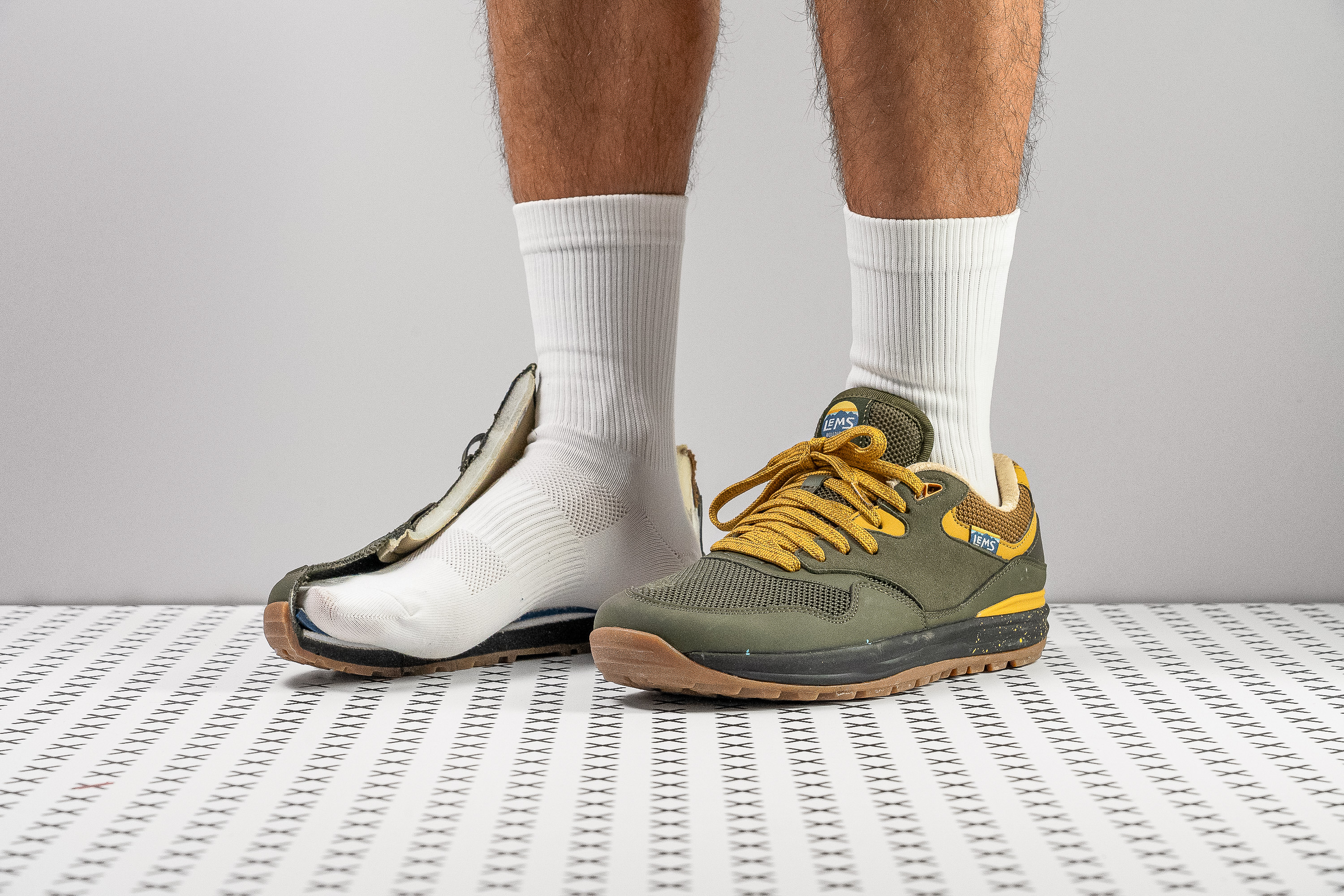Our verdict
- Top pick in best shoes for light hiking
Pros
- Perfect trail-to-city shoe
- Notably lighter than average
- Wear-resistant upper and outsole
- Grounded platform
- Low heel-toe drop confirmed
- Very flexible construction
- Upper follows natural foot shape
- Great grip for moderate terrain
- Vegan materials (in most colorways)
- Perfect for mild demi-season weather
Cons
- Not for wide feet
- Tongue slides sideways
- Not for warm weather
Audience verdict
- Top 6% in hiking shoes
- Top 5% in lightweight hiking shoes
Comparison
The most similar hiking shoes compared
+ + Add a shoe | |||||
|---|---|---|---|---|---|
| Audience score | 92 Superb! | 84 Good! | 85 Great! | 80 Good! | |
| Price | $140 | $70 | $170 | $175 | |
| Trail terrain | LightModerate | LightModerate | Light | Moderate | |
| Shock absorption | - | Moderate | High | - | |
| Energy return | - | Moderate | High | - | |
| Weight lab Weight brand | 11.9 oz / 337g 11.7 oz / 332g | 13.4 oz / 380g 12.3 oz / 350g | 11 oz / 312g | 14.5 oz / 410g 14.9 oz / 423g | |
| Lightweight | ✓ | ✓ | ✓ | ✗ | |
| Breathability | Moderate | Breathable | Moderate | Breathable | |
| Use | Day HikingLight HikingUrban hiking | Day HikingLight HikingBeginners | Day HikingLight HikingUrban hiking | Day HikingLight HikingUrban hiking | |
| Orthotic friendly | ✓ | ✓ | ✓ | ✓ | |
| Drop lab | 5.4 mm | 13.7 mm | 9.1 mm | 8.0 mm | |
| Size | True to size | True to size | Slightly small | True to size | |
| Midsole softness | Balanced | Balanced | Firm | Balanced | |
| Difference in midsole softness in cold | Small | Big | Normal | Small | |
| Torsional rigidity | Flexible | Stiff | Moderate | Stiff | |
| Heel counter stiffness | Flexible | Moderate | Flexible | Moderate | |
| Stiffness | Stiff | Flexible | Moderate | Stiff | |
| Outsole hardness | Average | Average | Average | Average | |
| Material | Mesh | LeatherMeshSuede | Mesh | Knit | |
| Season | All seasons | SummerAll seasons | All seasons | SummerAll seasons | |
| Toebox durability | Good | Very good | Decent | Very bad | |
| Heel padding durability | Good | Bad | Bad | Bad | |
| Outsole durability | Good | Decent | Good | Decent | |
| Width / fit | Narrow | Medium | Medium | Narrow | |
| Toebox width | Medium | Medium | Wide | Medium | |
| Lug depth | 3.0 mm | 3.2 mm | 2.5 mm | 3.7 mm | |
| Heel stack lab | 27.1 mm | 32.7 mm | 35.5 mm | 39.0 mm | |
| Forefoot | 21.7 mm | 19.0 mm | 26.4 mm | 31.0 mm | |
| Widths available | Normal | NormalWide | Normal | Normal | |
| Technology | - | - | - | Vibram | |
| Heel tab | None | Finger loop | Finger loop | Finger loop | |
| Removable insole | ✓ | ✓ | ✓ | ✓ | |
| Ranking | #2 Top 6% | #21 Bottom 40% | #19 Bottom 45% | #26 Bottom 25% | |
| Popularity | #24 Bottom 31% | #25 Bottom 28% | #19 Bottom 45% | #35 Bottom 1% |
Who should buy
Having tested the Lems Trailhead through and through, we believe that it is a great option for people who seek the following:
- a moderately minimalist shoe for a gradual transition from high-drop and cushy platforms to more barefoot-like footwear
- a highly versatile trail-to-town shoe for everything: streets to yardwork, biking to trail hiking, traveling, and more
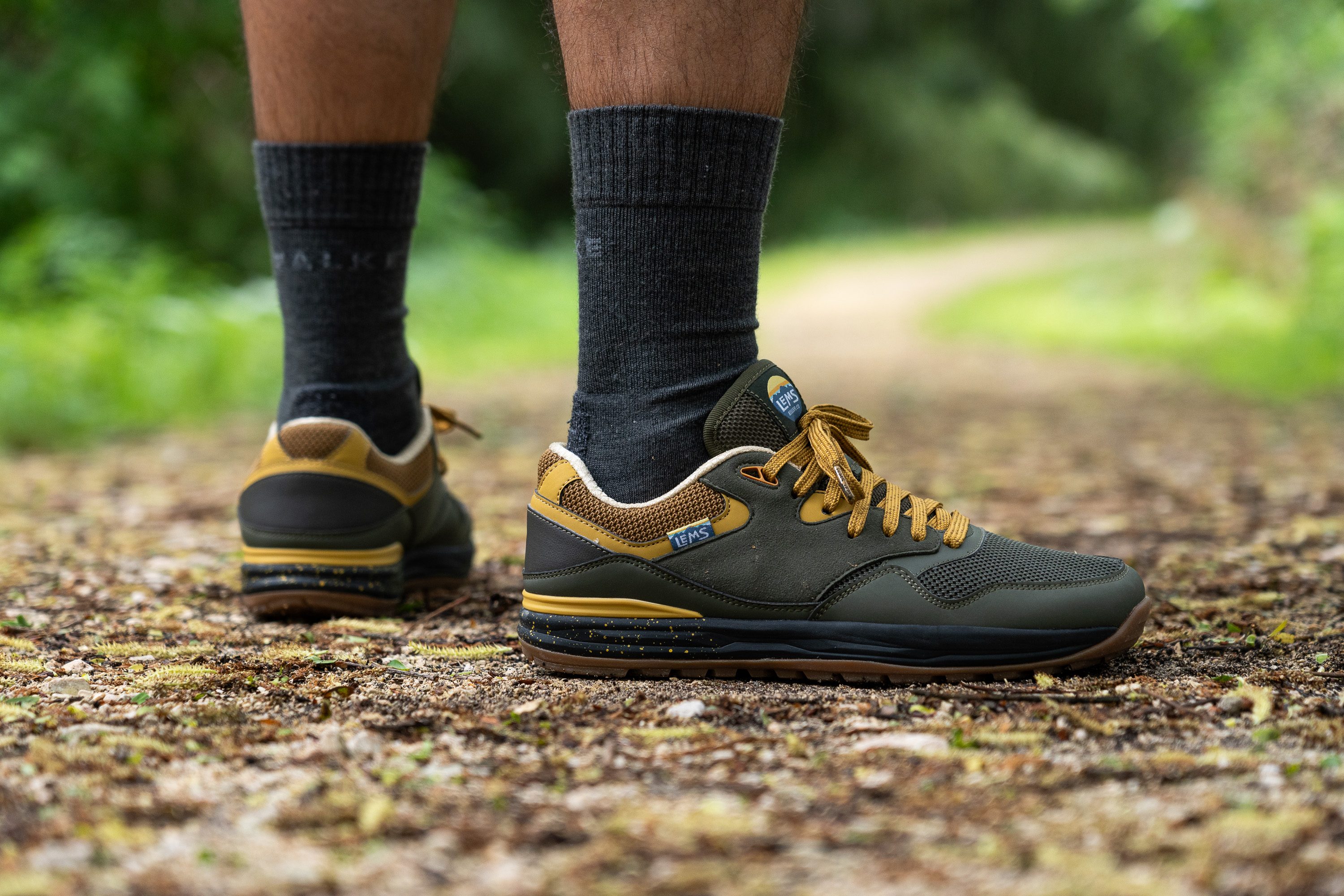
Who should NOT buy
People with wide feet may not find the Trailhead's Medium Fit spacious enough in the forefoot. Instead, we recommend the Primal Pursuit as it's built on the brand's Wide Fit last.
Another reason to skip this Lems shoe is if you are used to having more support and cushioning in your hiking shoes. The Merrell Moab 3 will be a more reliable companion on long hiking trips with a backpack.
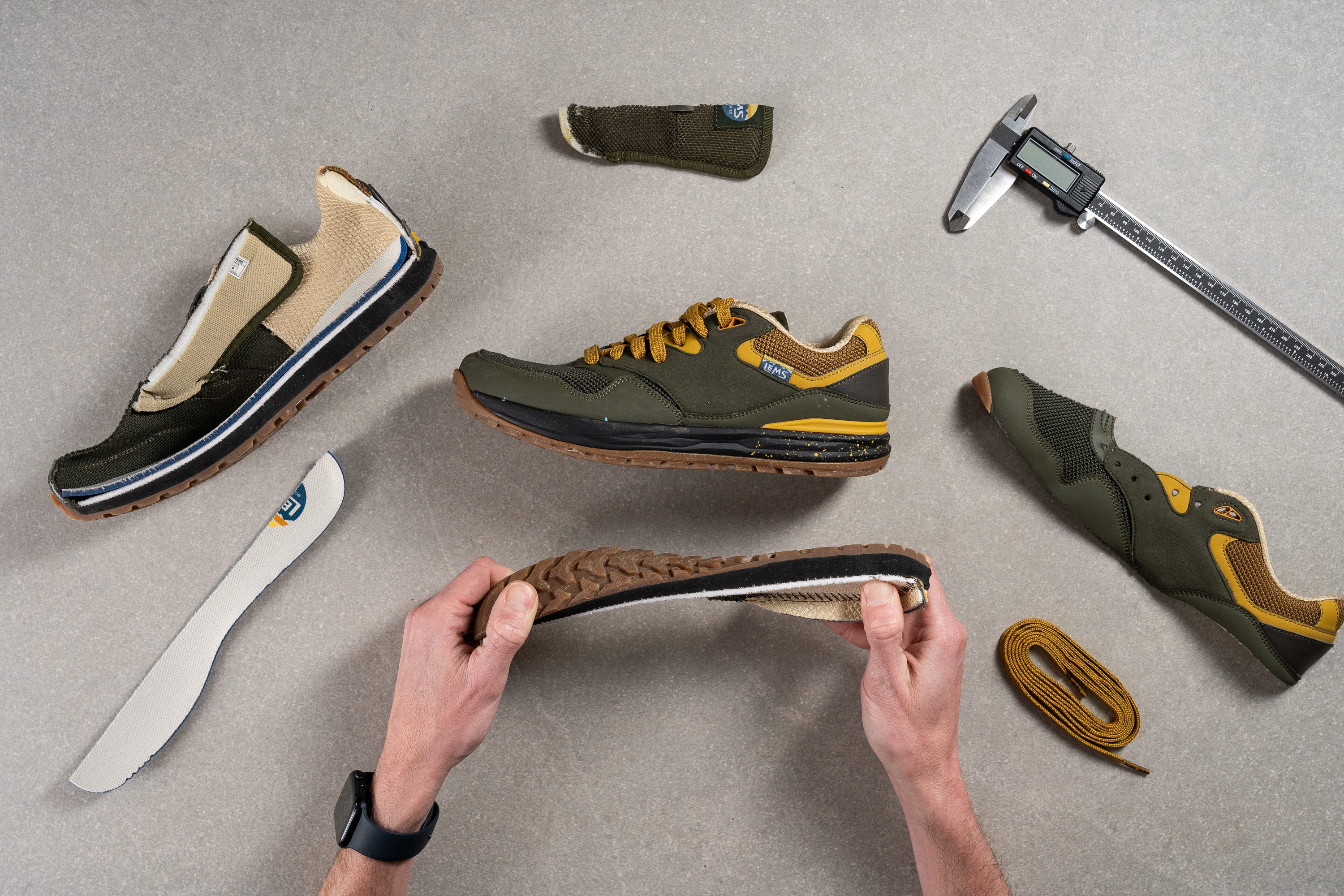
Cushioning
Heel stack
Because Lems is so strongly associated with barefoot-like shoes, you might think that the Trailhead is rather minimal too.
Especially since the official specs say that the shoe's heel stack is only 21 mm tall.
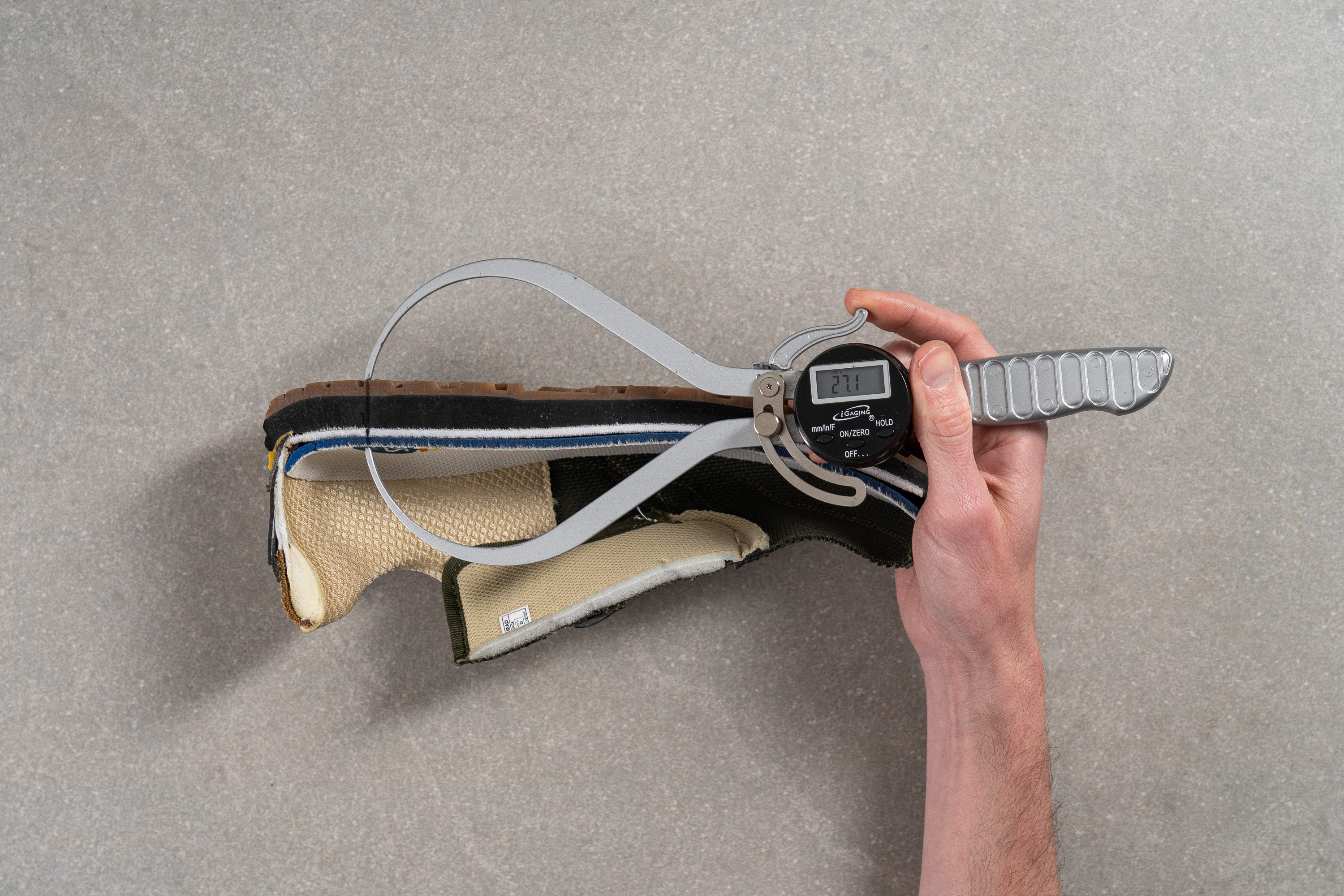
But in reality, the Trailhead sits somewhere in between. Measuring the shoe's stack height in the heel, our caliper showed 27.1 mm. A whole 6 mm thicker than what the brand says!
Sure, it is on the lower side of the hiking shoe spectrum but it is only about 4 mm lower than average. And it is not much lower than the best-selling KEEN Targhee III (29.5 mm).
From our personal experience, the Lems Trailhead provides a decent amount of impact protection for spending several hours on foot. Be it on hard asphalt or softer park trails, we felt sufficiently supported all throughout the wear test.
But if you are used to taller and cushier platforms like Hoka, the Trailhead is going to feel alien.
| Trailhead | 27.1 mm |
| Average | 32.8 mm |
Forefoot stack
We came across another discrepancy in the specs when measuring the shoe's forefoot stack.
Instead of the promised 17 mm, our caliper returned an impressive 21.7 mm! That's even a millimeter taller than average!
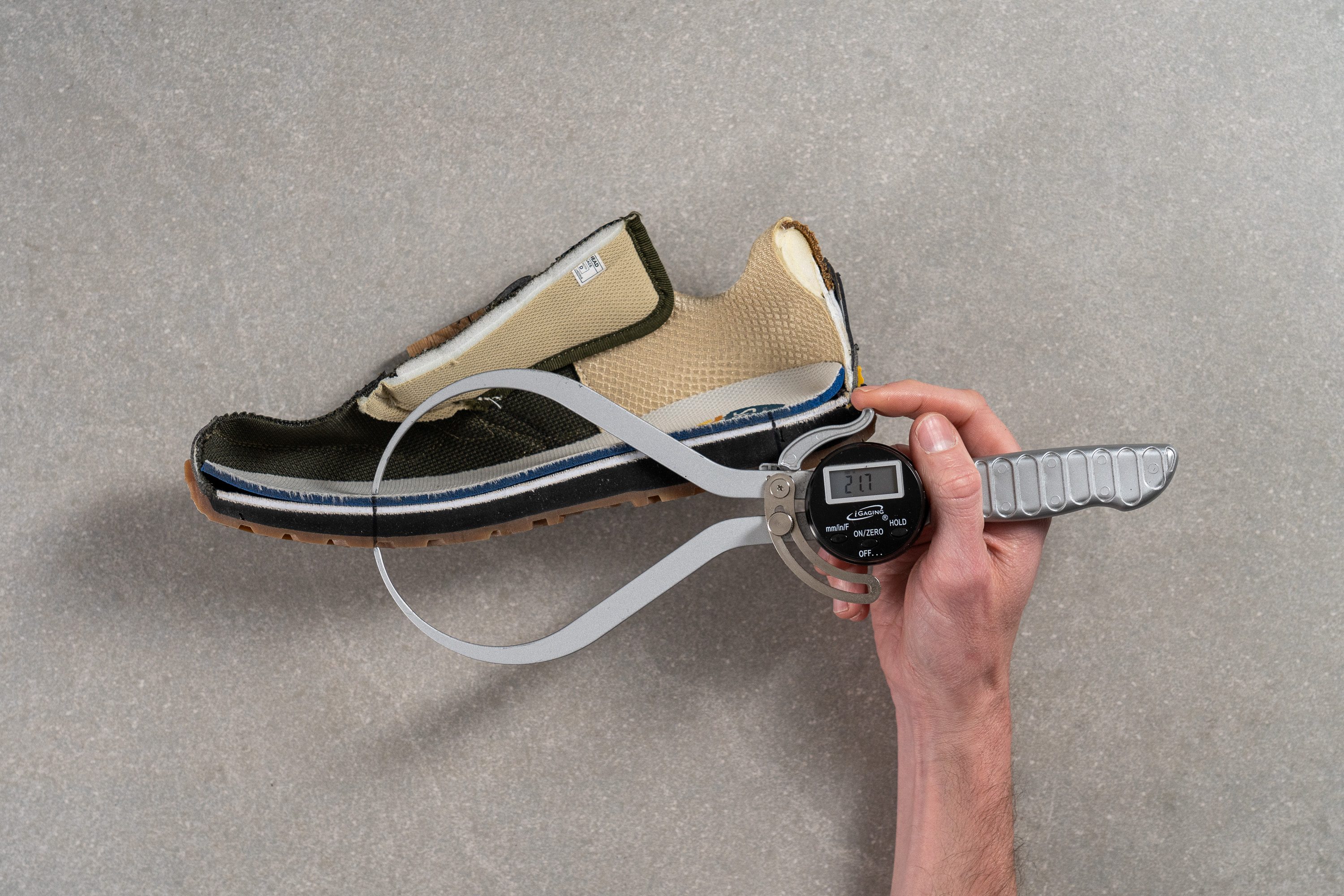
This may or may not be good news depending on what kind of underfoot experience you are looking for. If you expect an intimate ground feel, that's not it.
| Trailhead | 21.7 mm |
| Average | 22.0 mm |
Drop
Given that the stack measurements were off, it is expected that the shoe's heel-to-toe drop would deviate as well.
But the discrepancy is not so bad - we got 5.4 mm instead of the official 4 mm. A vast majority of wearers will not even notice the difference.
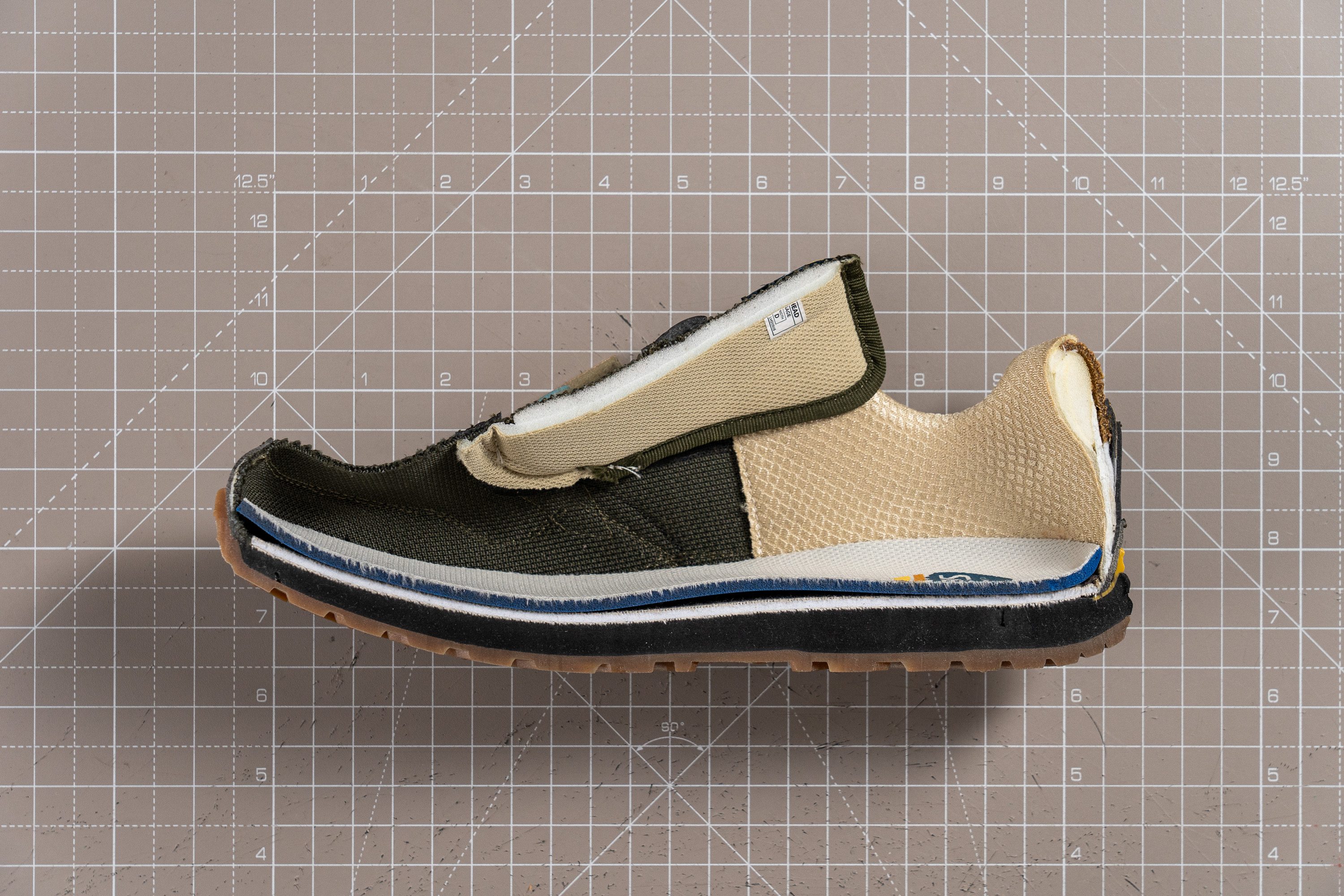
We found that the Trailhead still provides that relatively flat positioning of the foot in which the heel is only slightly elevated above the toes. This setup encouraged more engagement in our ankles and Achilles and the landings were less heel-dominant.
| Trailhead | 5.4 mm |
| Average | 10.7 mm |
Midsole softness
You will not find a soft shoe in the Lems product lineup.
That's because the brand deems plush cushioning as a cause of foot discomfort and even pain! However, we found it to be only partially true in our in-depth research on soft vs. firm cushioning.
Wear-testing the Trailhead, we experienced a moderately firm (but not exactly firm) midsole which had just enough give for shock absorption.
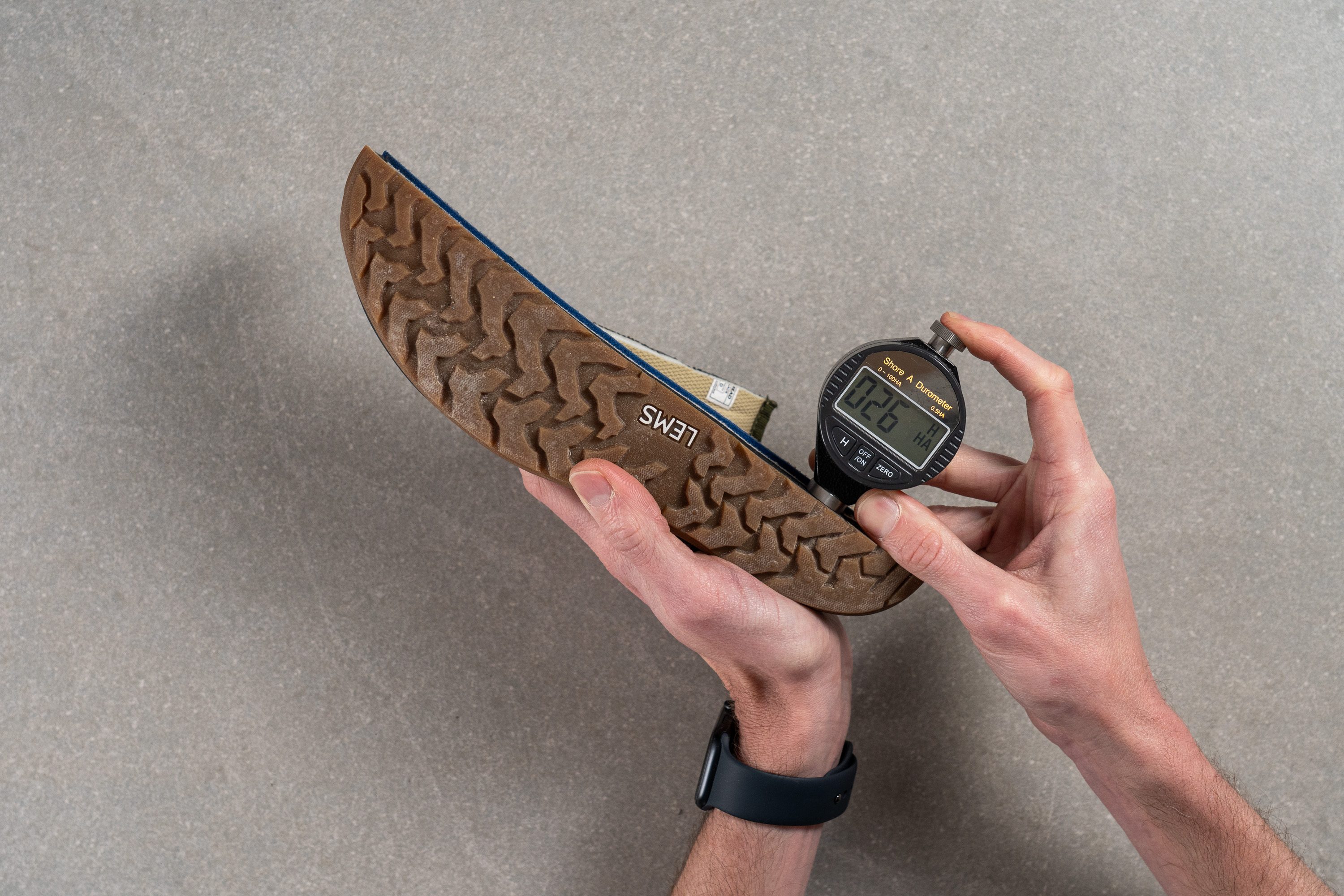
With a durometer measurement of 26.0 HA, the shoe's cushioning is not even firmer than the average of hiking shoes. It sits right in the middle.
| Trailhead | 26.0 HA |
| Average | 27.0 HA |
Size and fit
Size
Lems Trailhead fits true to size (13 votes).
Width / Fit
If you've worn Lems footwear in the past, you must be expecting plenty of space in the Trailhead. But let us warn you that the Trailhead has a snugger profile than most shoes from the brand.
Using a proprietary gel, we retrieved the mold of the shoe's interiors and measured its widest area with a caliper. A modest reading of 90.04 mm confirmed that the Trailhead is about 4 mm narrower than the average hiking shoe!
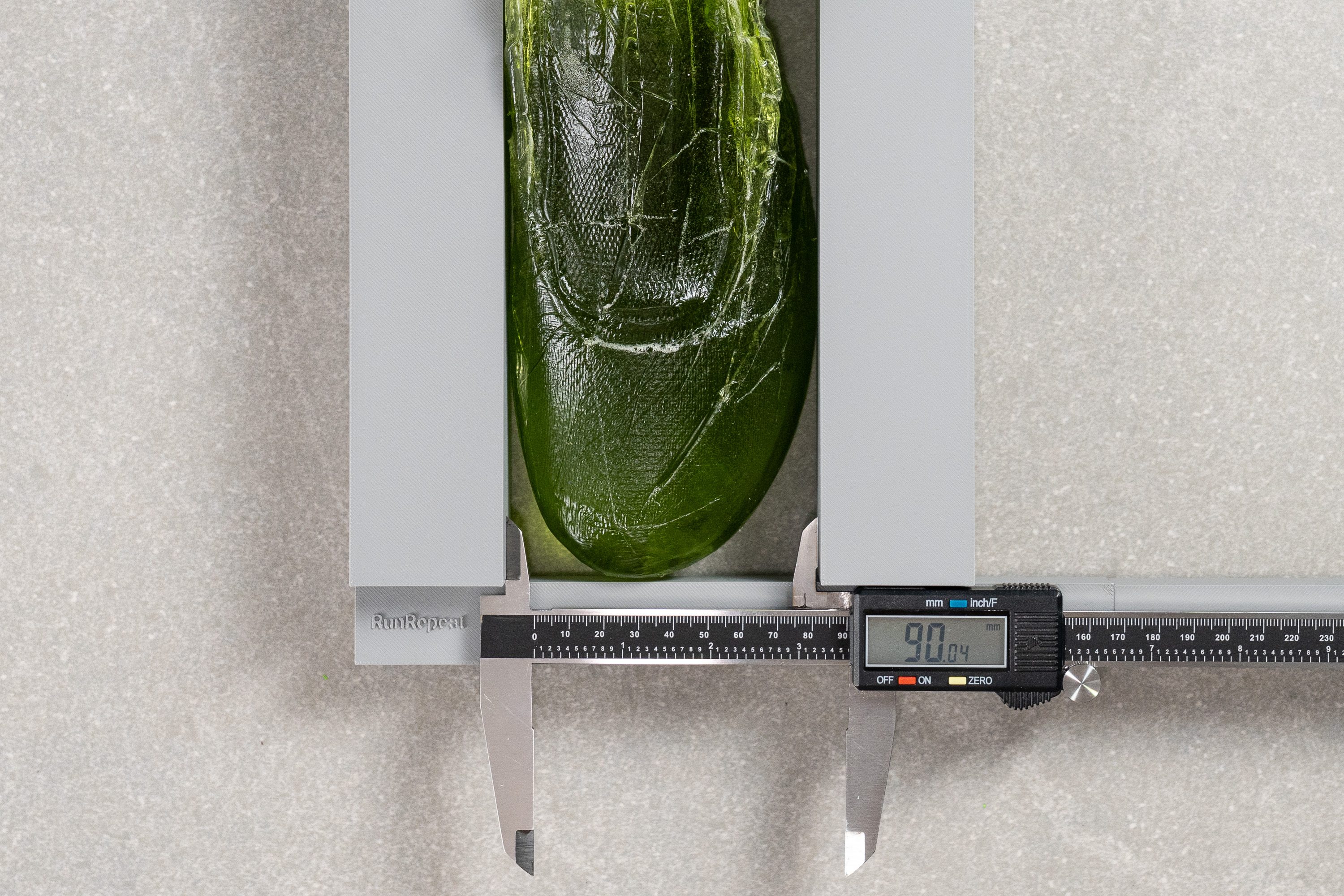
| Trailhead | 90.0 mm |
| Average | 94.1 mm |
Toebox width
On the bright side, this Lems shoe still follows the natural shape of the foot (as promised) and has a rounded toebox to accommodate all five toes. Albeit, it is slimmer than the brand's other silhouettes like the Primal 2.
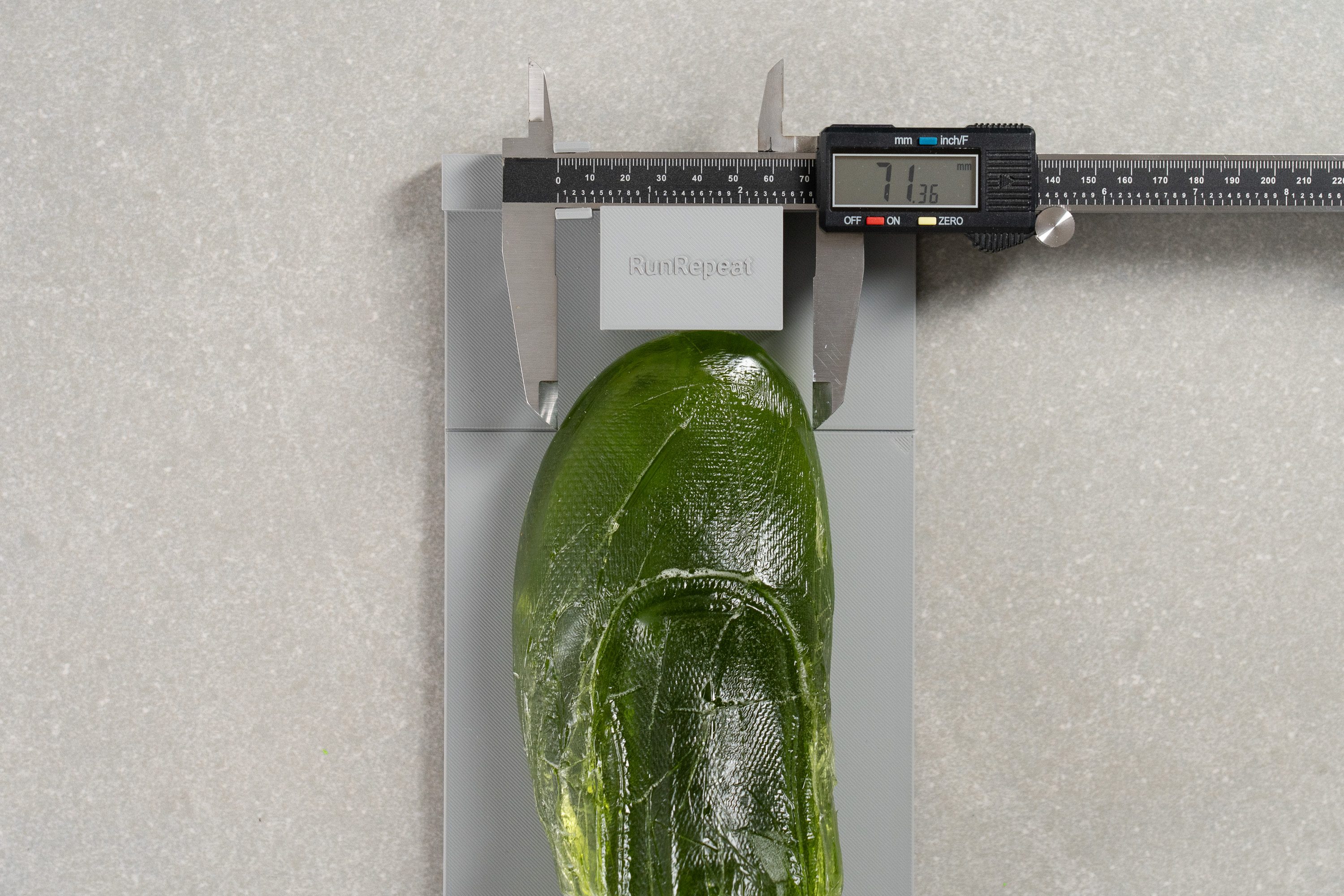
Our caliper recorded a slightly narrower-than-average reading of 71.36 mm.
Thus, we cannot recommend the Trailhead to people with wide feet and bunions. We think that these folks would appreciate the Lems Primal Pursuit more (it has the brand's Wide Natural-Shape Fit).
| Trailhead | 71.4 mm |
| Average | 72.5 mm |
Toebox height
Gladly, the vertical space of the Trailhead's toebox compensates for some of the in-shoe volume. It is slightly above average at 29.39 mm.
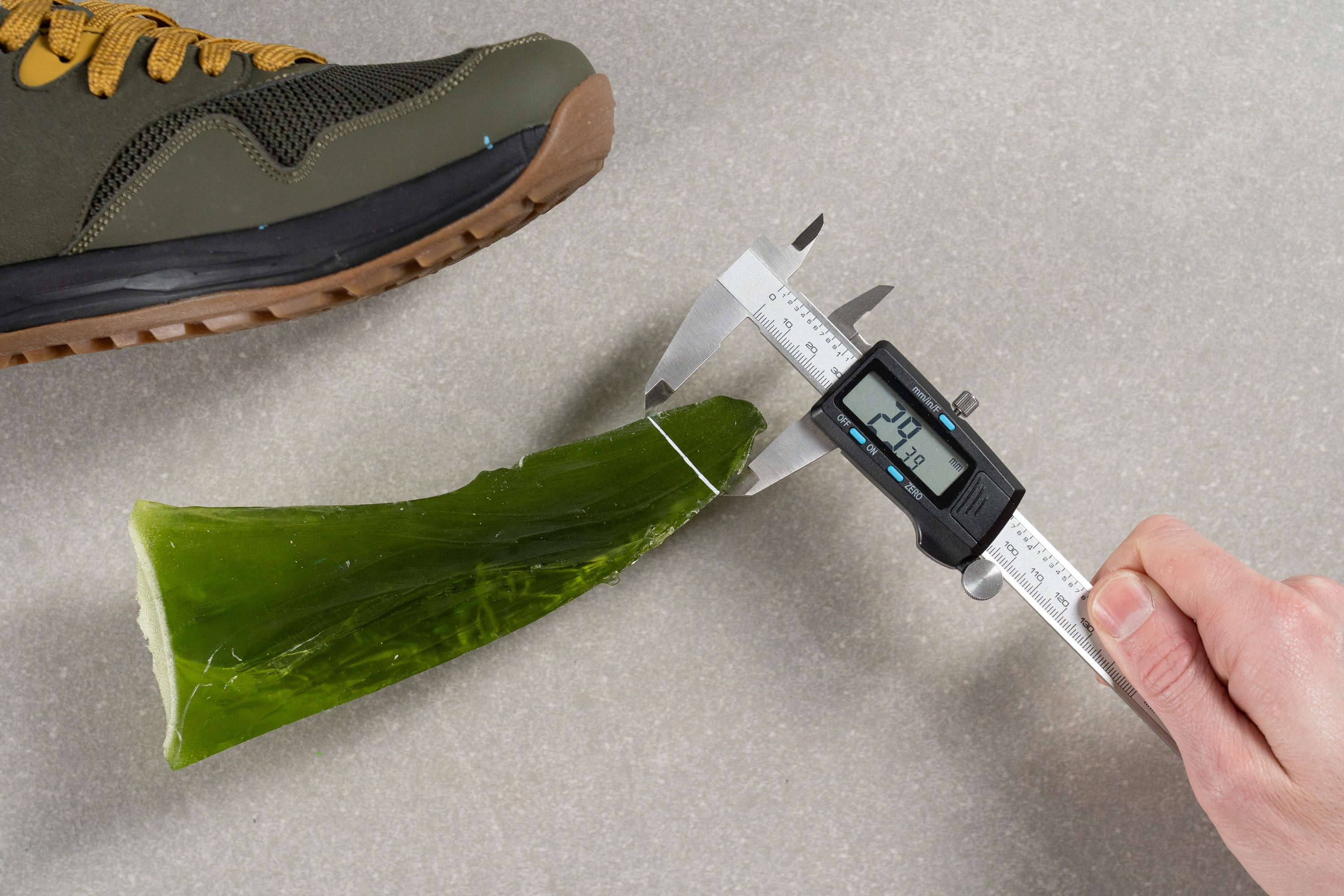
| Trailhead | 29.4 mm |
| Average | 28.0 mm |
Laces
We approve of the wide flat laces used in the Trailhead. They are easy to cinch up and let loose and stay tied in between.

An additional eyelet at the top of the collar can be used by people with narrower feet to tighten up the shoe with a runner's knot.
Traction / Grip
Lug depth
Having tested the Lems Trailhead in urban and moderate outdoor scenarios, we can confirm that the shoe's outsole is very adaptable.
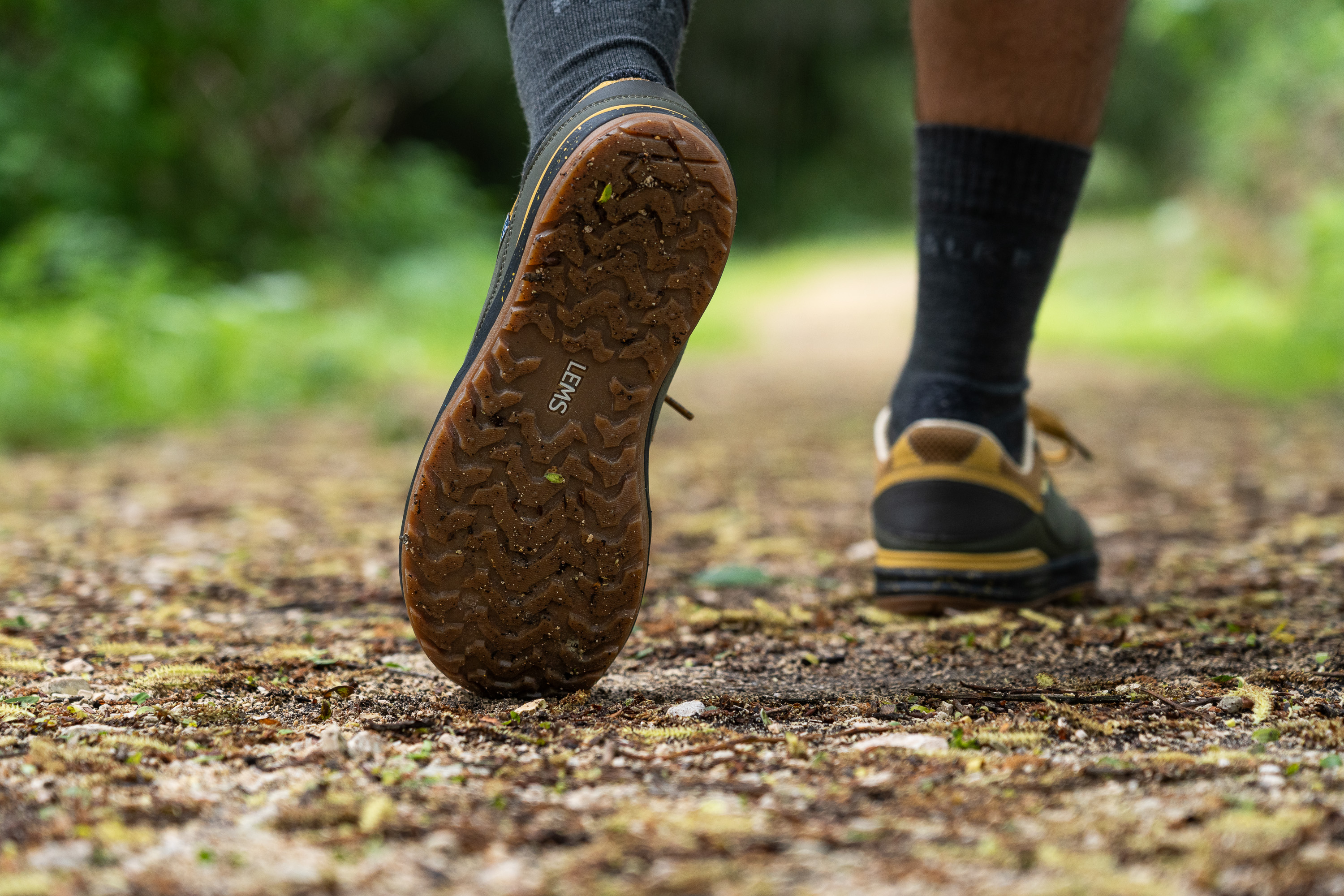
With its non-aggressive 3.0 mm lugs, the shoe can seamlessly transition from the pavement to the trail without affecting comfort or grip.
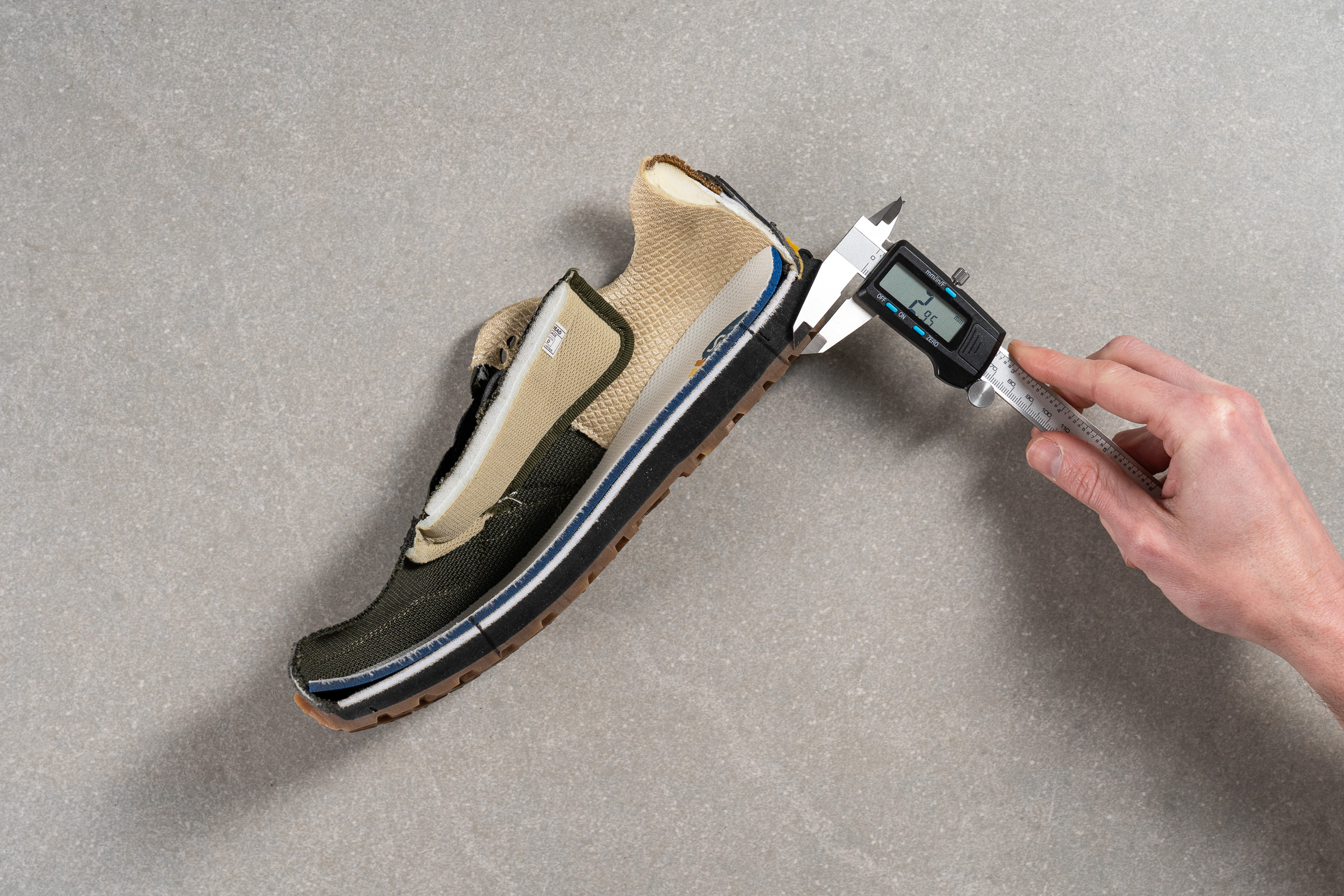
The shoe bit onto boulders and moss-covered rocks without a problem. Its multi-directional lugs also kept us surefooted when going downhill.
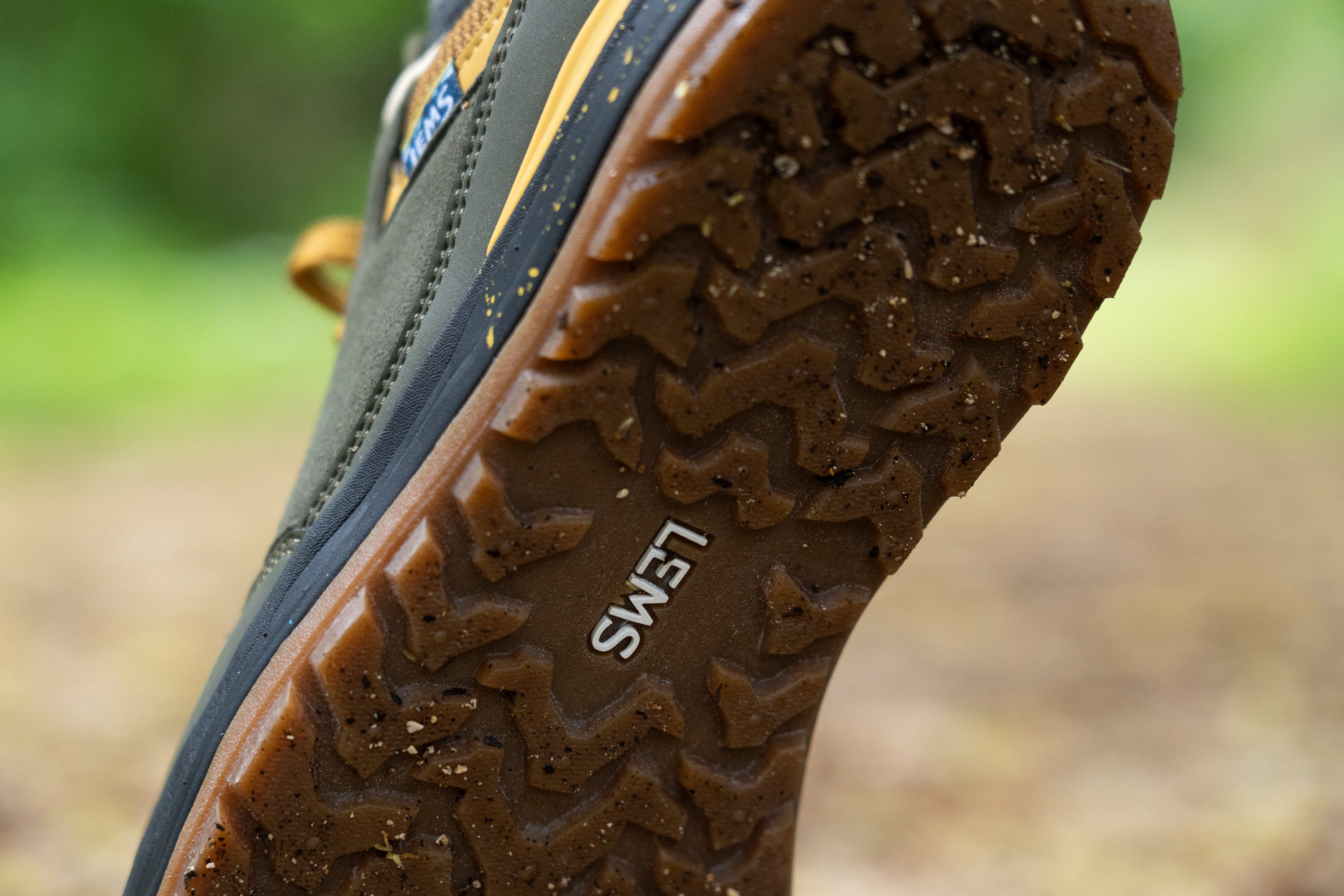
| Trailhead | 3.0 mm |
| Average | 4.0 mm |
Flexibility / Stiffness
Due to the lack of stability-boosting components, the Lems Trailhead turns out to be more flexible than a typical hiking shoe.
Let us highlight once again that this shoe feels a lot like a casual sneaker on foot.
Measuring the amount of force it takes to bend this Lems shoe to a 90-degree angle (24.1N), we found that it requires 22% less than average.
This test follows an older methodology, which is why you don't see recently tested shoes in the chart. Results from different methodologies can not be compared.
| Trailhead | 24.1N |
| Average | 29.6N |
Stiffness in cold (%)
But does it get any stiffer in cold conditions? It does not!
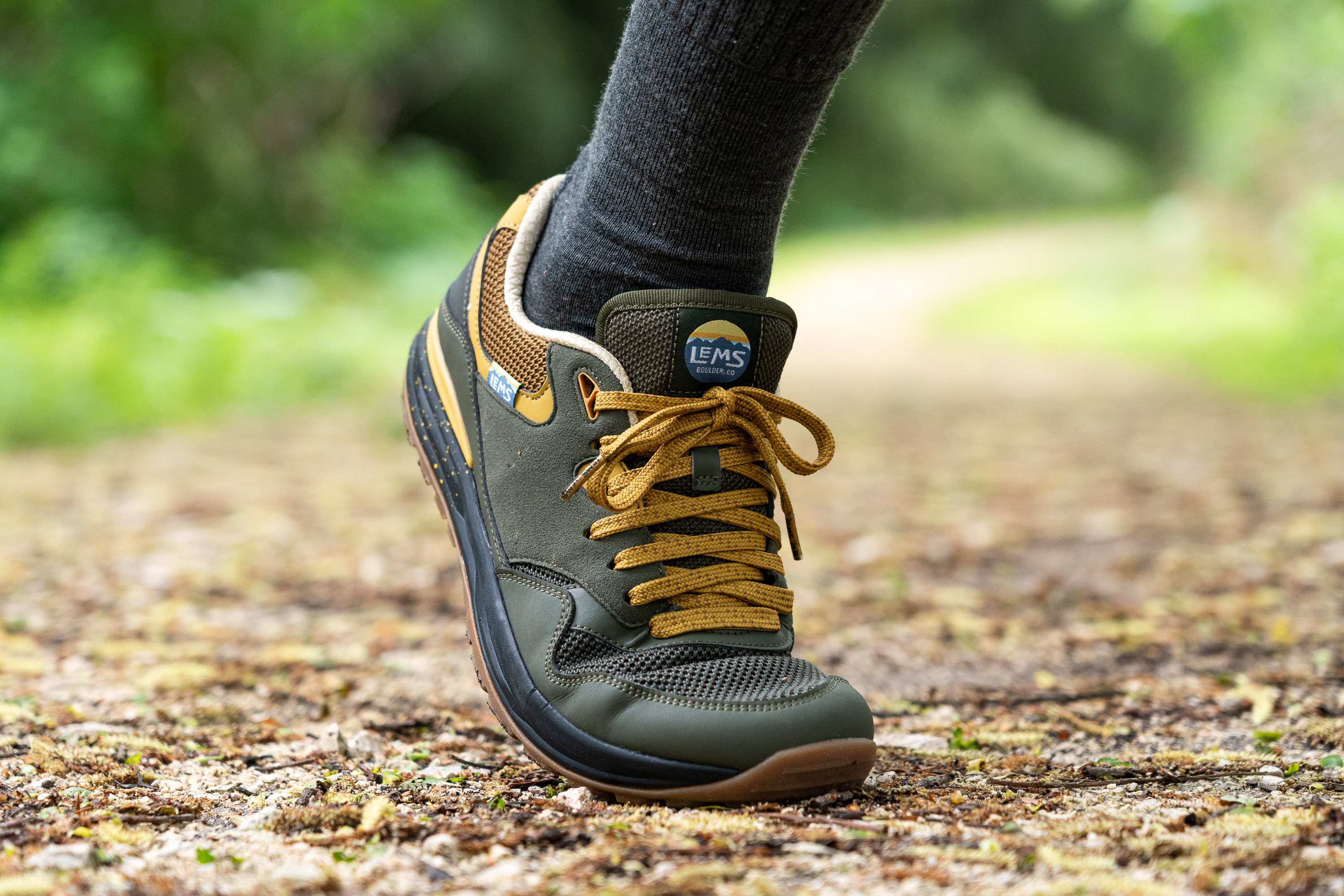
After keeping the Trailhead in the freezer for 20 minutes and retaking the force gauge measurement, we found that the difference was only 6.2%! This is way smaller than the average 30%.
| Trailhead | 6% |
| Average | 28% |
Weight
As a brand that promotes minimalist footwear, Lems tends to keep the weight of its shoes to a minimum. And this proves to be true for the Lems Trailhead as well.
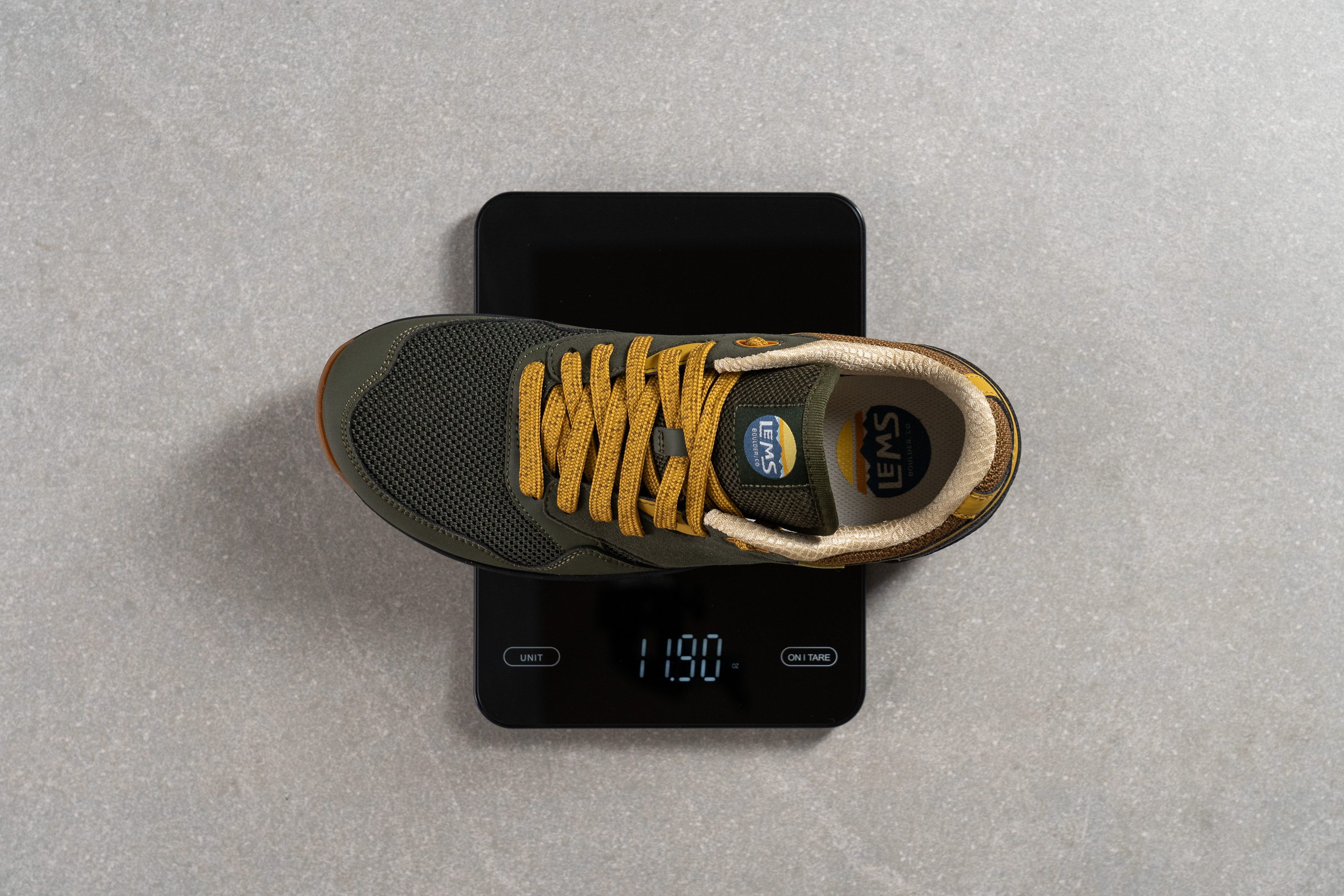
Showing 11.9 oz (337g) on our scale, the shoe is almost 1.5 oz lighter than the average. We were happy to see nothing extra about the Trailhead. The simplicity of its design is what appeals to us the most.
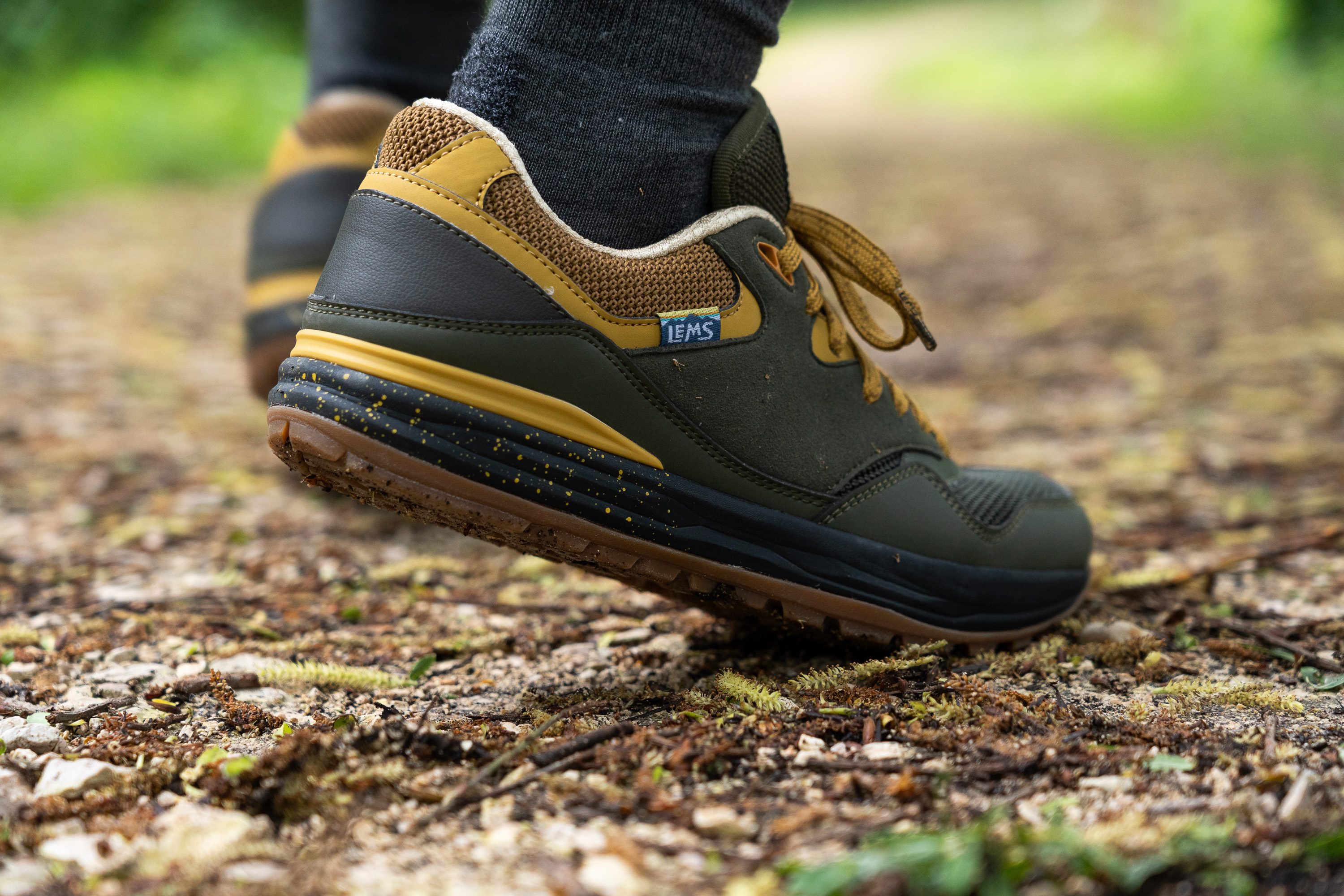
However, we must also mention that the Trailhead is not as light as presented in the brand's official specs. The Lems website states 11.7 oz in a men's US 10 but that can't be true as we got 11.9 oz in a men's US 9 alone.
| Trailhead | 11.9 oz (337g) |
| Average | 13.4 oz (380g) |
Breathability
We found that the Lems Trailhead makes for a perfect demi-season pair - it's neither too airy nor too warm. Its sweet spot lies between 50°F (10°C) and 70°F (20°C).
Look how little smoke was able to escape through the shoe's upper in our smoke-pumping breathability test.
The shoe uses mesh panels for ventilation, but the threads are pretty thick and tightly woven, hindering the airflow. The dense inner lining beneath the mesh also impacts the shoe's overall breathability. You can see how limited the shoe's ventilation pores are in our transparency test below.
Checking the shoe's mesh fabric up close through a microscope made us think for a moment that we were looking at a sweater.
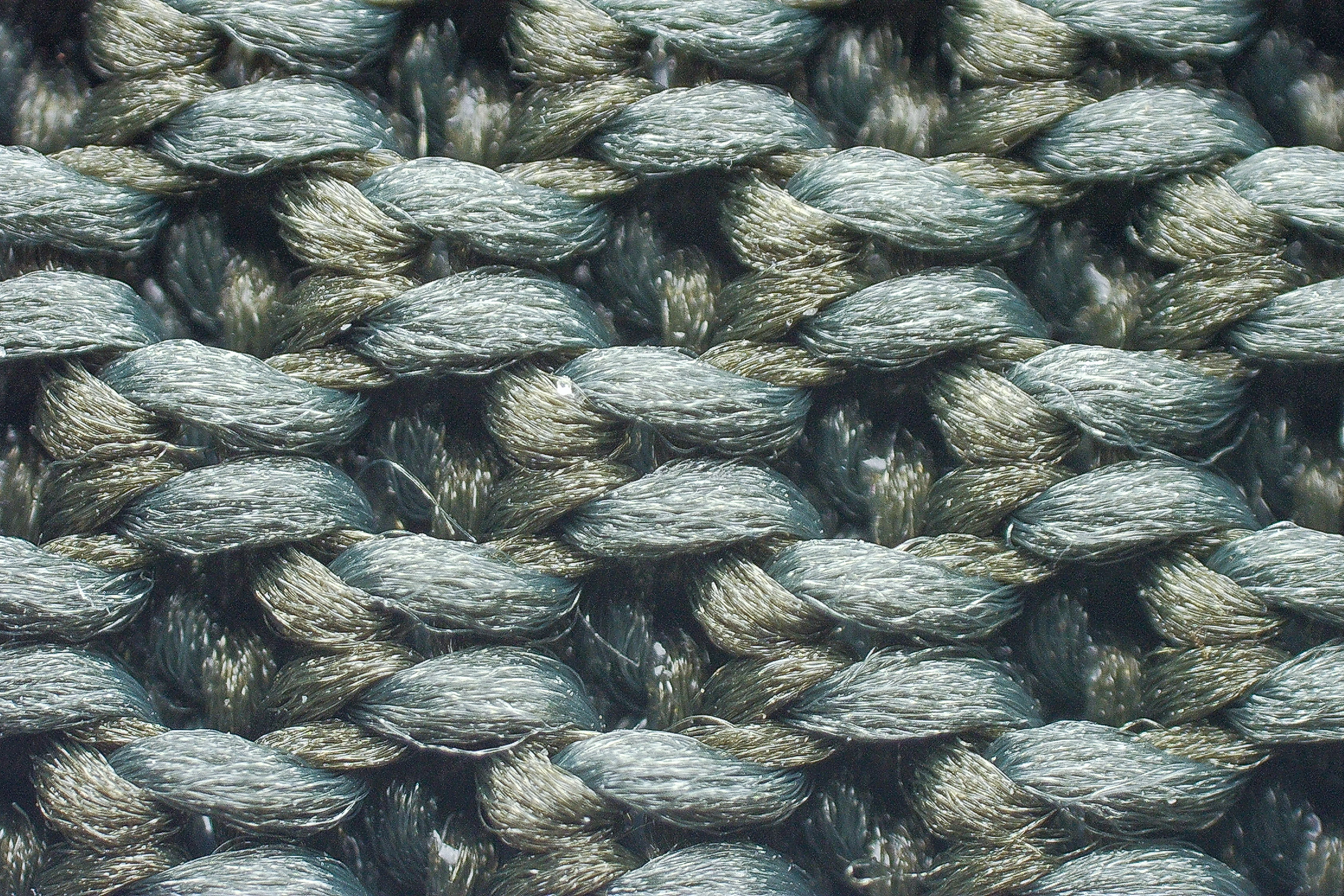
But because the shoe is not entirely deprived of ventilation, we rated its breathability with a moderate score of 3 out of 5. Rather typical for a hiking shoe.
| Trailhead | 3 |
| Average | 2.4 |
Stability
Lateral stability test
Even though the Lems Trailhead doesn't have any stabilizing components, it feels stable on account of its grounded platform.
We believe that the shoe has enough inherent stability for people with flat feet and light-to-moderate overpronation.
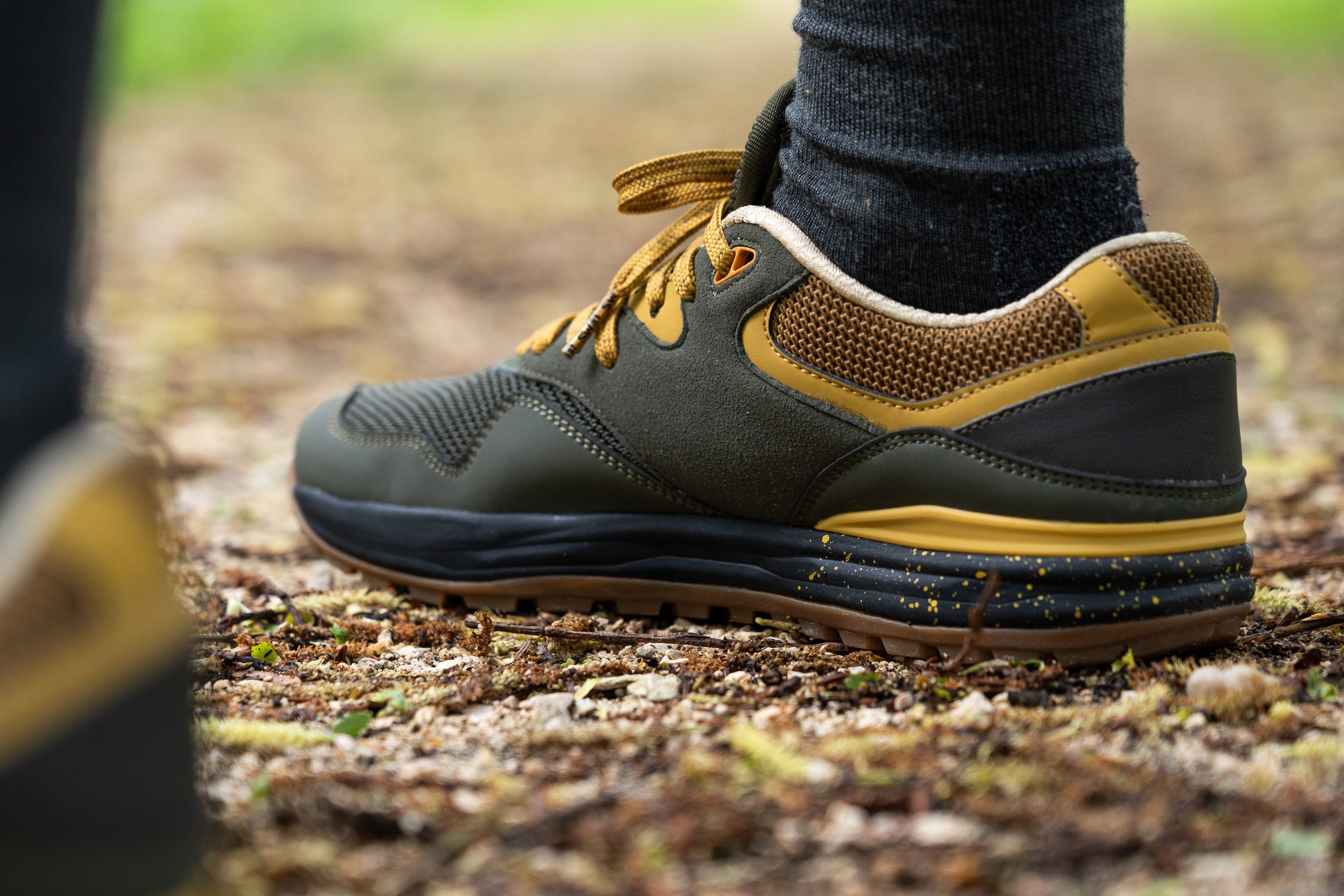
But let's not forget that the Trailhead is more of a sneaker-hiker hybrid. It is not intended for carrying heavy backpacks on tricky terrain. That's why it doesn't have the same amount of stability as a typical hiking shoe.
Torsional rigidity
Because natural foot movement is the cornerstone of Lems shoes, you won't find any plates or stability shanks in the Trailhead.
Our manual test above demonstrates that the shoe is pretty easy to twist compared to the more rugged hikers.
On a stiffness scale from 1 to 5, where 5 is the stiffest, we couldn't rate it any higher than 2.
| Trailhead | 2 |
| Average | 3.7 |
Heel counter stiffness
We are happy to report that the Lems Trailhead doesn't feel sloppy around the heel. Its rearfoot portion offered enough structure and firmness to keep our heels and ankles securely in place.
Assessing the shoe's heel counter stiffness in our manual test, we gave it a moderate score of 3 out of 5. Not as stiff as the average hiking shoe but solid for a town-to-trail sneaker.
| Trailhead | 3 |
| Average | 3.7 |
Midsole width - forefoot
Looking at the bottom of the Trailhead, we found that its landing area follows the natural width and shape of the foot without protruding too far off on the sides.
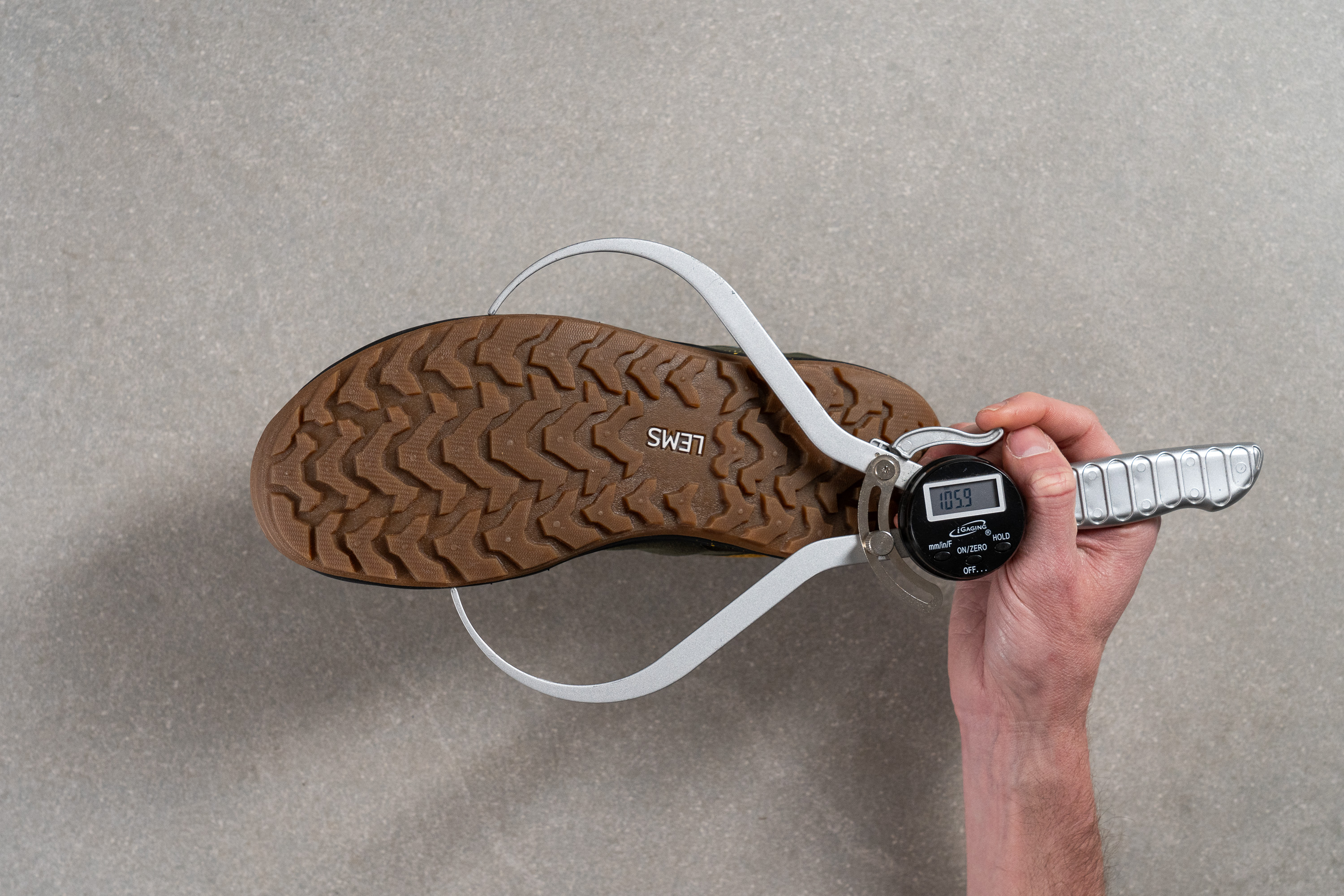
That's why it doesn't feel as bulky and platformy as a typical hiking shoe.
Measuring its sole in the widest area returned 105.9 mm. which is narrower than the average but on par with a regular medium-width foot.
| Trailhead | 105.9 mm |
| Average | 111.3 mm |
Midsole width - heel
The widest part of the Trailhead's heel showed only 79.8 mm. It is narrower than average, yes, but not enough to compromise stability. We would call it neutral.
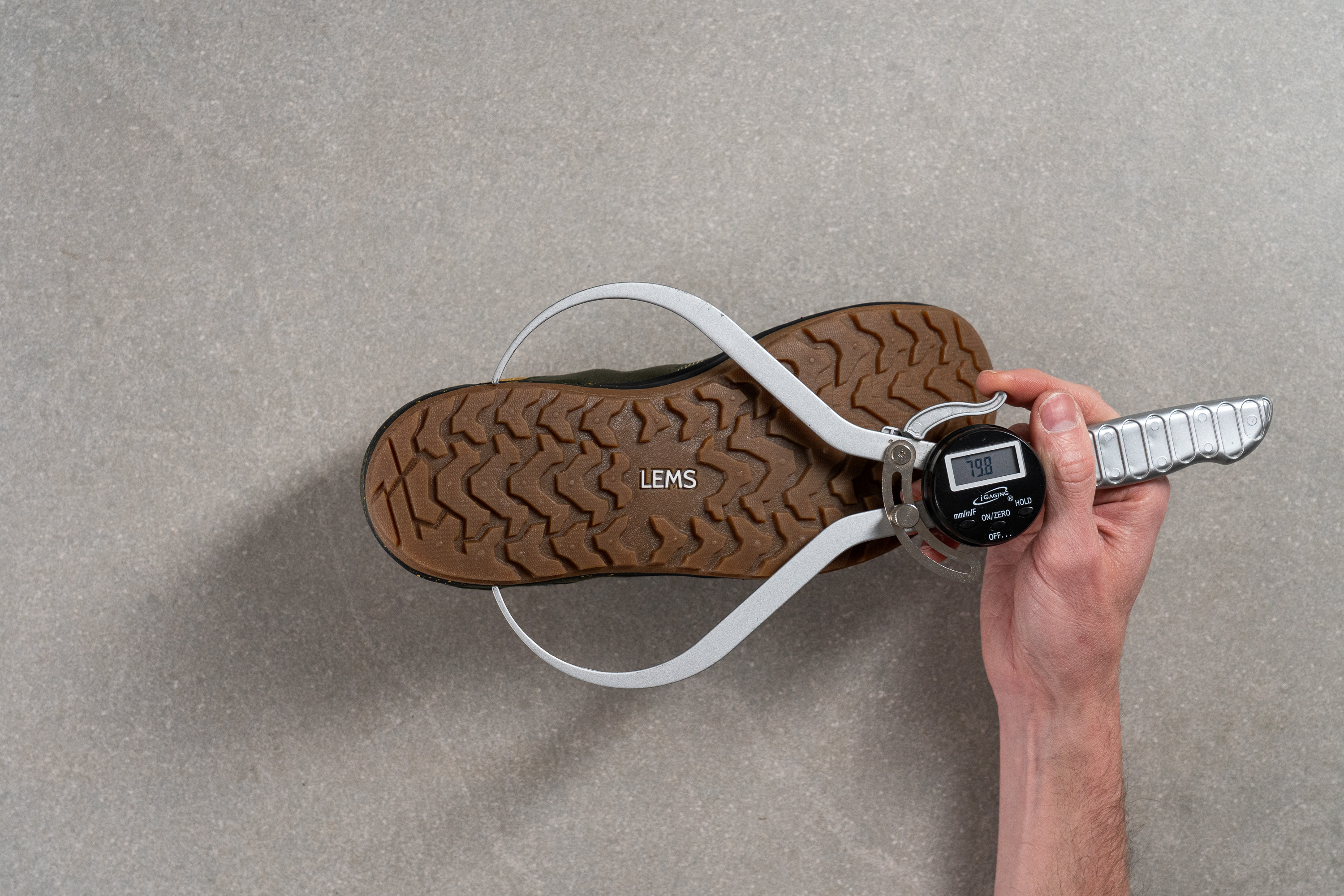
| Trailhead | 79.8 mm |
| Average | 87.9 mm |
Durability
Toebox durability
Even though the Trailhead uses a lot of mesh in its upper, we thought that it looked sturdy enough for moderate trail conditions. But why assume when we can test?
We turned to the sandpaper tip of our Dremel to check how much abrasion the shoe's toebox mesh could take. The drilling lasted for 12 seconds with the Dremel speed set to 5K RPM and the pressure remaining consistent at 3.2N.
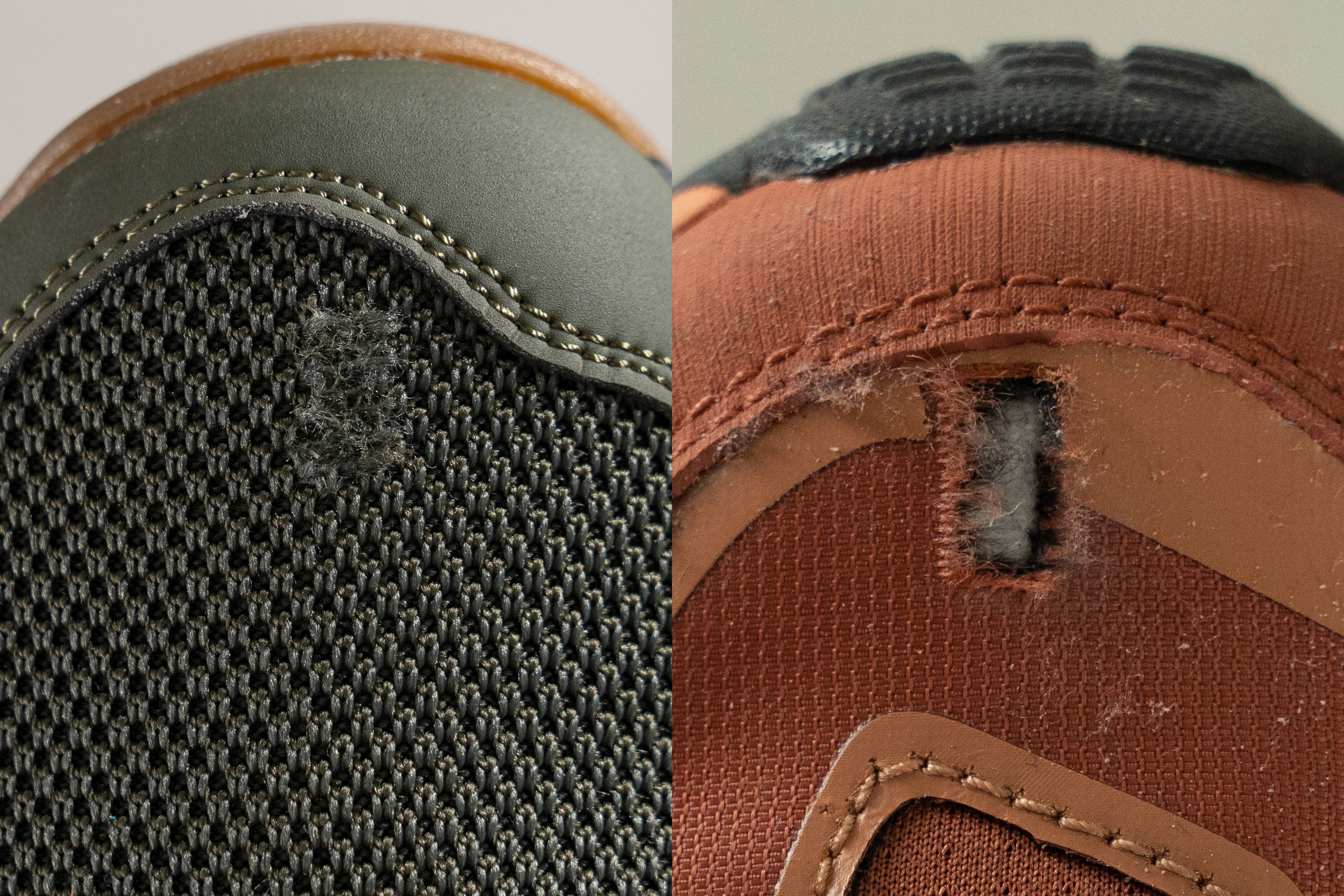
The result was stunning as the Trailhead's mesh proved to be even more wear-resistant than the synthetic uppers of some other hiking shoes! We didn't hesitate to rate shoe's toebox durability with a high score of 4 out of 5.
Wading through bushes or tripping over roots will not easily destroy the Trailhead's upper.
| Trailhead | 4 |
| Average | 3.7 |
Heel padding durability
As it turned out, the inner textile of the Lems Trailheads is just as sturdy! This slick and soft fabric simply refused to give in to the sandpaper on our Dremel.
Four seconds of drilling showed barely visible damage which fairly earned the shoe's heel lining the highest durability score of 5 out of 5!
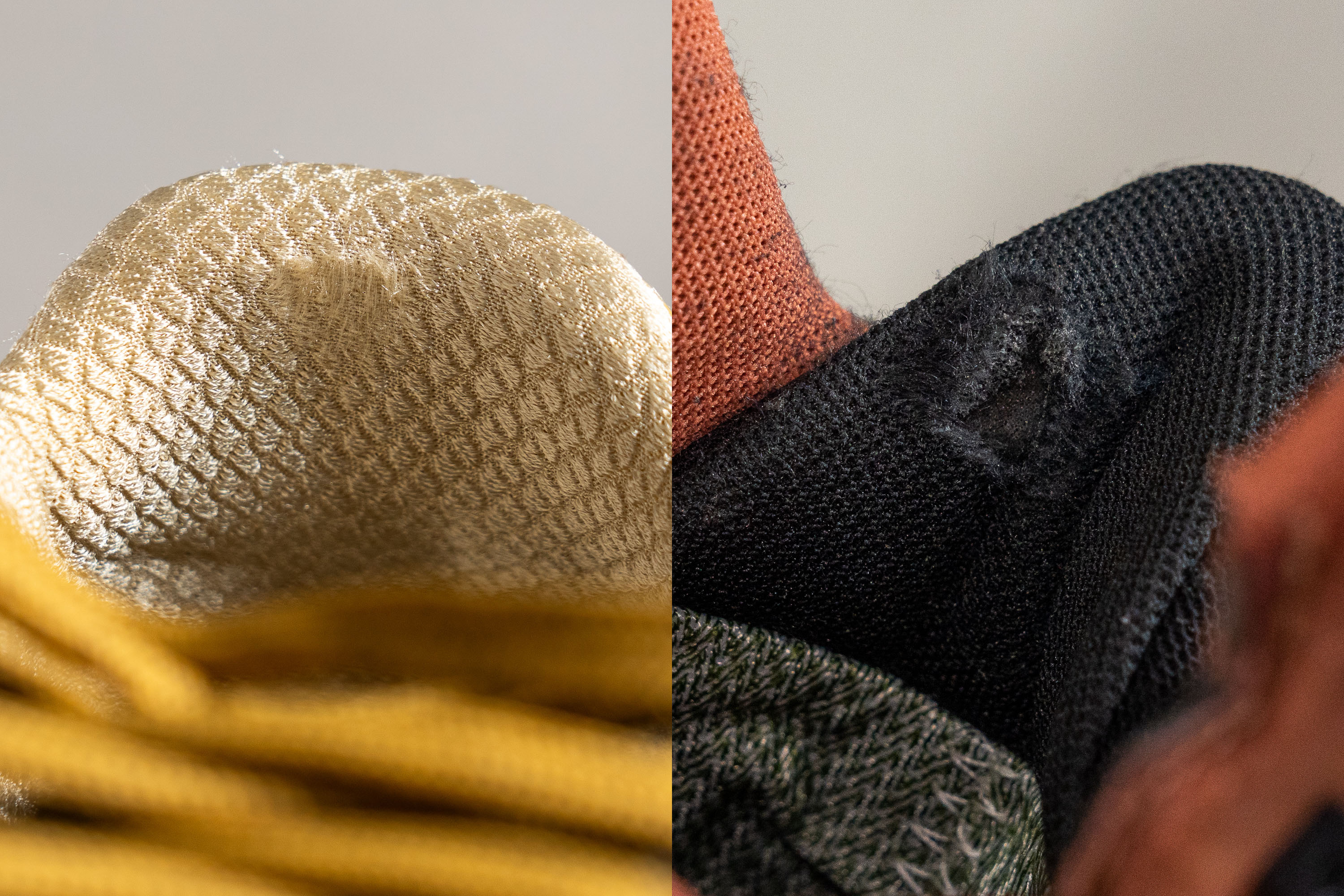
| Trailhead | 5 |
| Average | 3 |
Outsole hardness
Our durability expectations were now set high for the shoe's Mountain-to-Town outsole. Is it just as hard-wearing as the other hiking outsoles?

Our Shore C durometer showed a promising result of 80.5 HC. It indicates that the shoe's rubber hardness is within the typical range of trail-ready shoes in our lab.
| Trailhead | 80.5 HC |
| Average | 85.1 HC |
Outsole durability
We went full force setting the Dremel speed to 10K RPM and extending exposure time to 22 seconds. But the Lems Trailhead kept fighting back with vigor.
The indentation hardly even reached 1 mm! With a tread gauge measurement of 0.7 mm, this outsole proved to be stronger than the industry average.
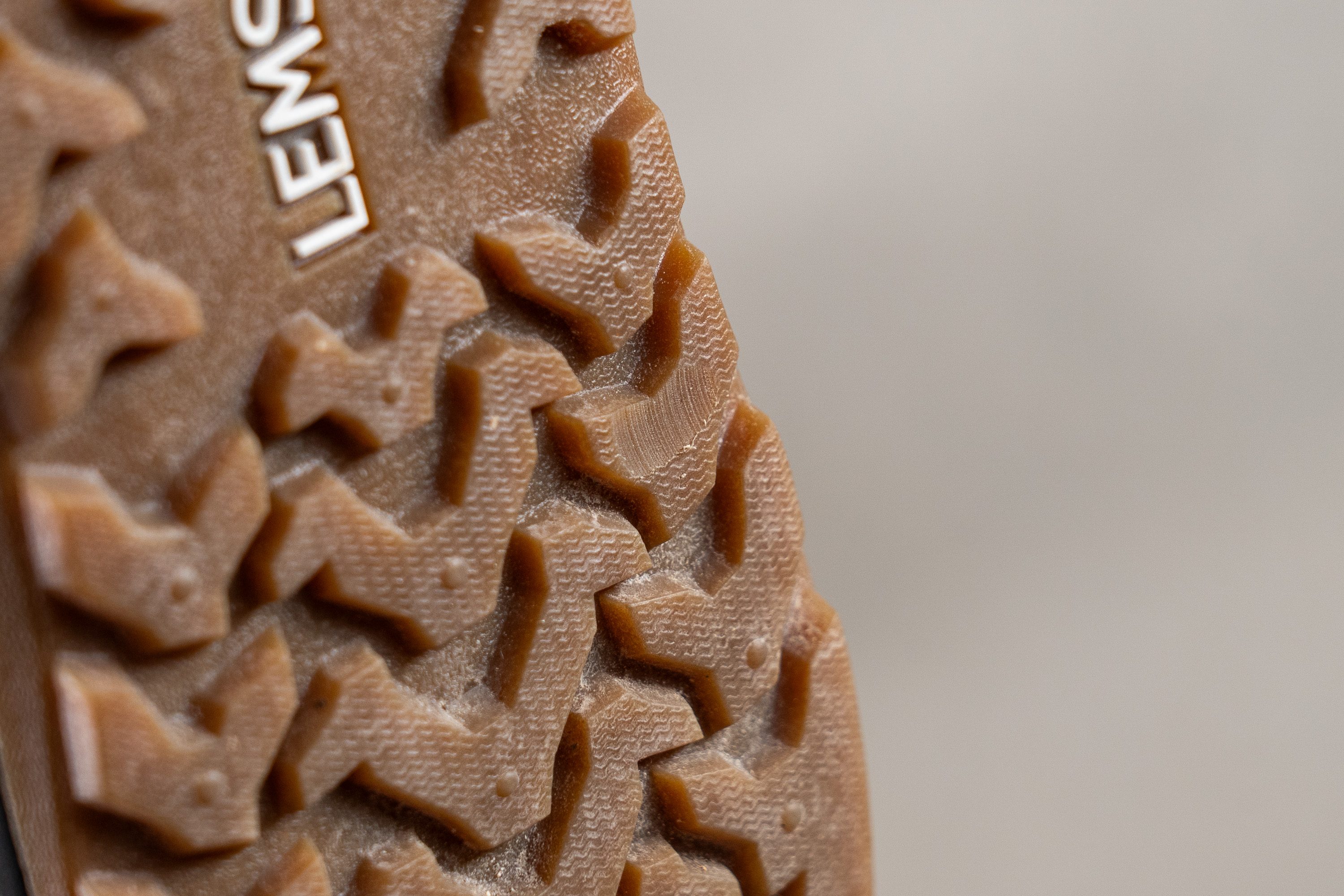
| Trailhead | 0.7 mm |
| Average | 1.0 mm |
Outsole thickness
Using a caliper, we also found that the Trailhead's rubber thickness was slightly above average at 3.0 mm.
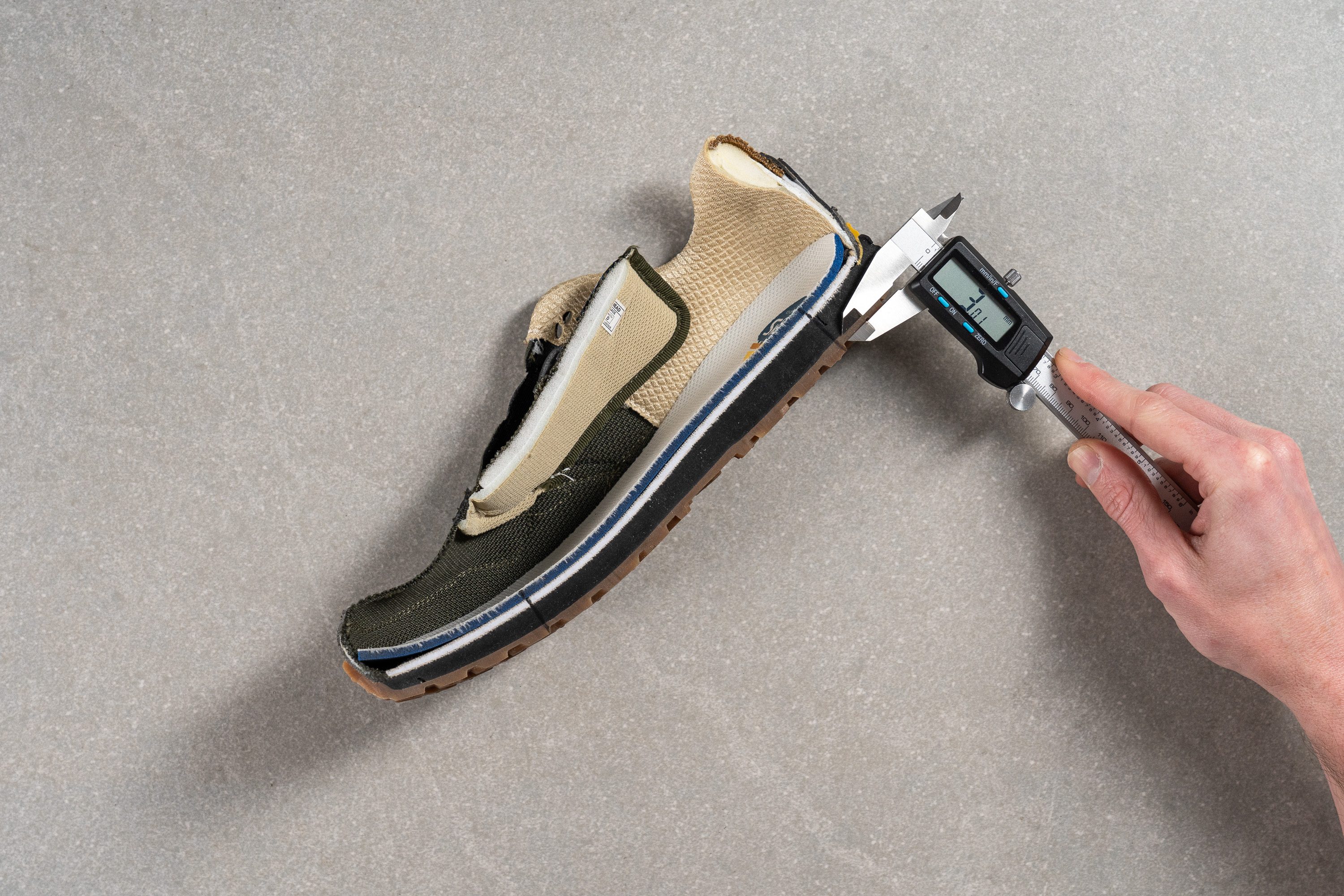
Pair that with 3-mm lugs and you get a solid 6-mm layer of outsole rubber to brave city pavements and moderately challenging trails.
| Trailhead | 3.0 mm |
| Average | 2.5 mm |
Misc
Insole thickness
The Trailhead's cushioning setup is completed by a moderately padded insole. Our caliper showed 4.5 mm in the heel which is about a millimeter thinner than the average.
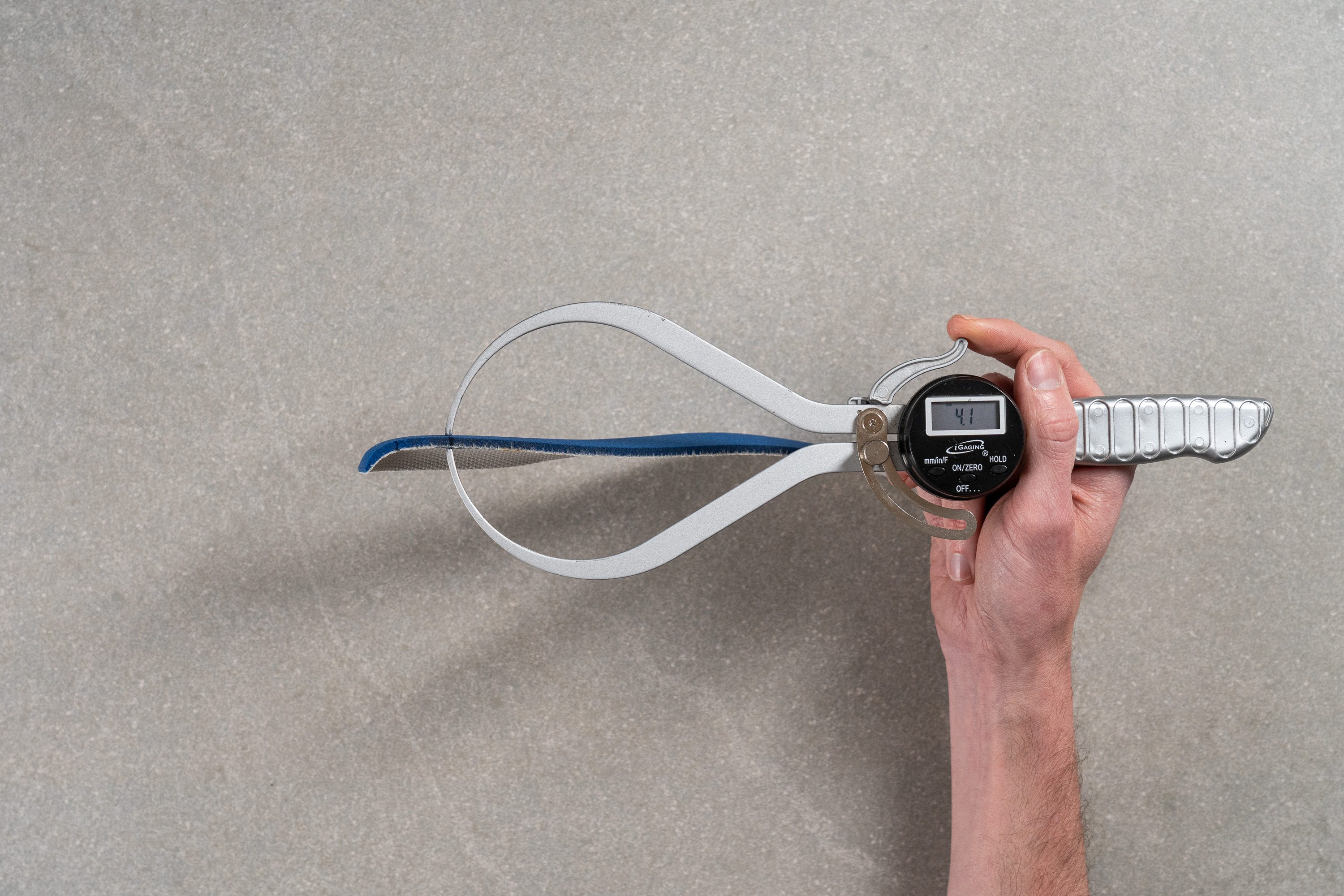
| Trailhead | 4.1 mm |
| Average | 5.3 mm |
Removable insole
The Lems Trailhead has a pretty nice contoured insole. But if you need a custom orthotic to achieve that fine-tuned support, you can easily replace the stock insert.

| Trailhead | Yes |
Midsole softness in cold (%)
If you plan to use the Trailhead during colder months, you might be pleasantly surprised that this Lems shoe doesn't get much harder in low temperatures.
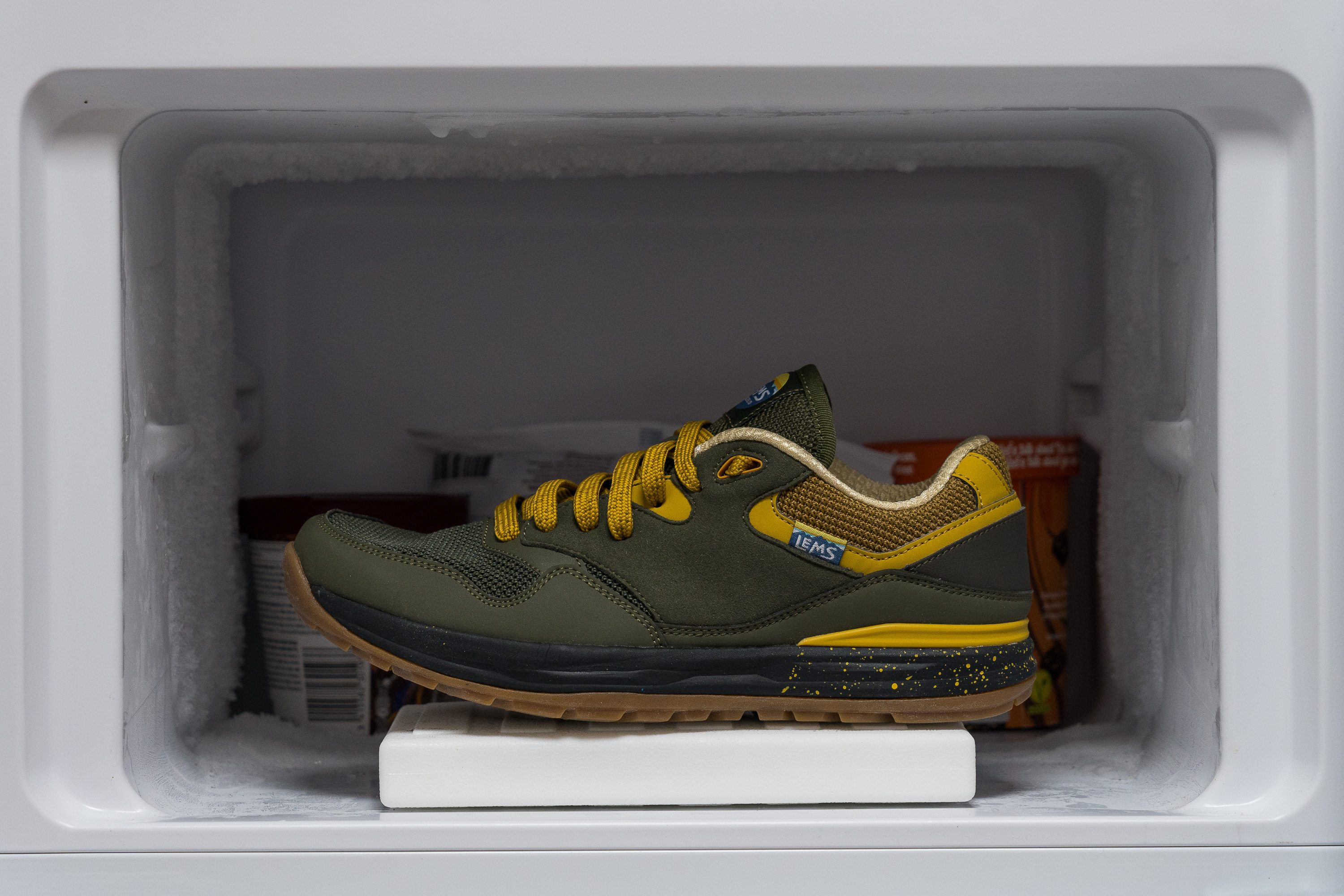
We repeated the durometer measurement after keeping the shoe in the freezer for 20 minutes and found that its cushioning only got 14.4% firmer.
| Trailhead | 14% |
| Average | 19% |
Reflective elements
There are no reflective elements on the Lems Trailhead. Be careful with that zero visibility at night.
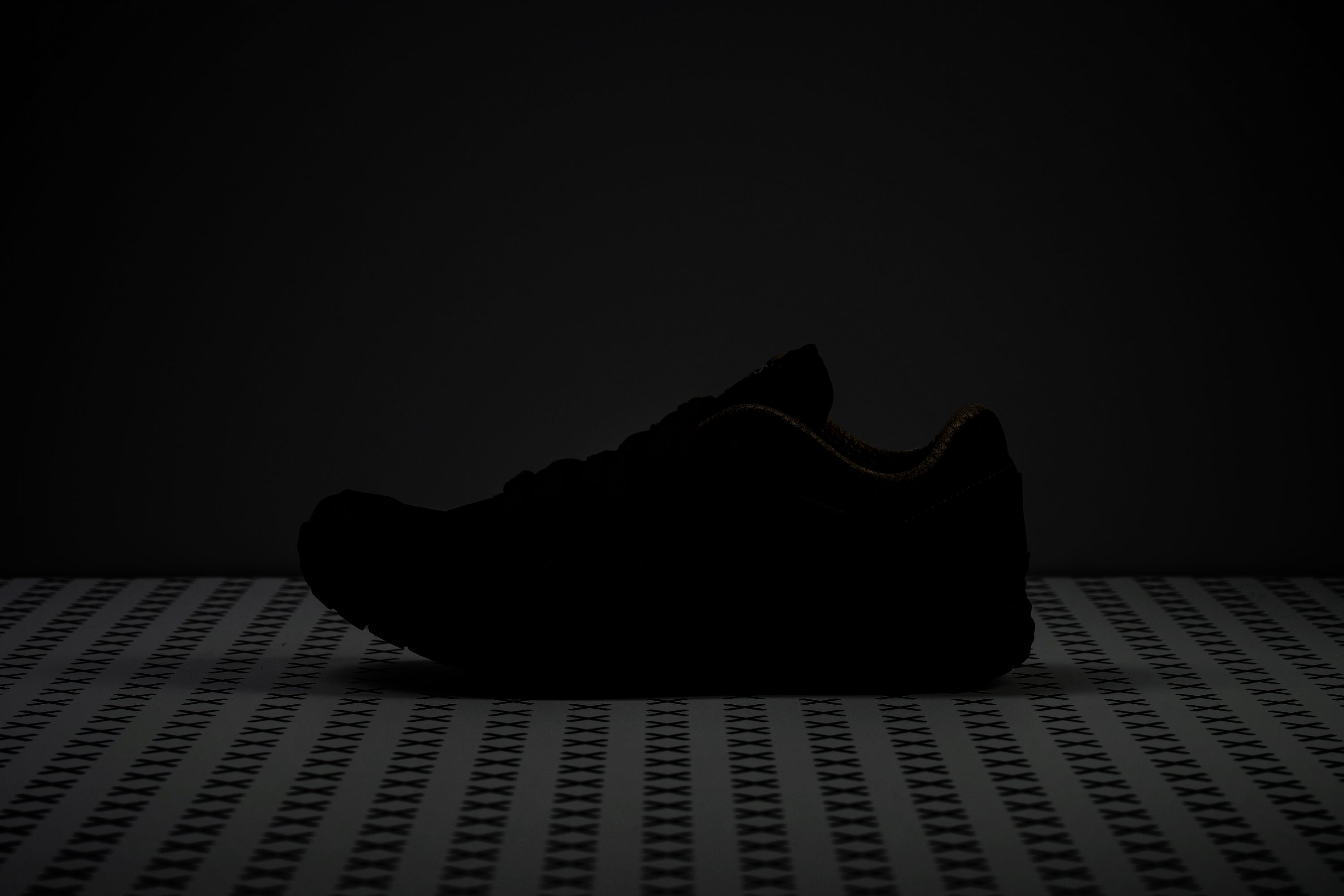
| Trailhead | No |
Tongue padding
Investigating the Lems Trailhead interiors, we found a rather well-padded tongue. Our caliper showed 9.5 mm of foam thickness which does a great job keeping lace pressure at bay.
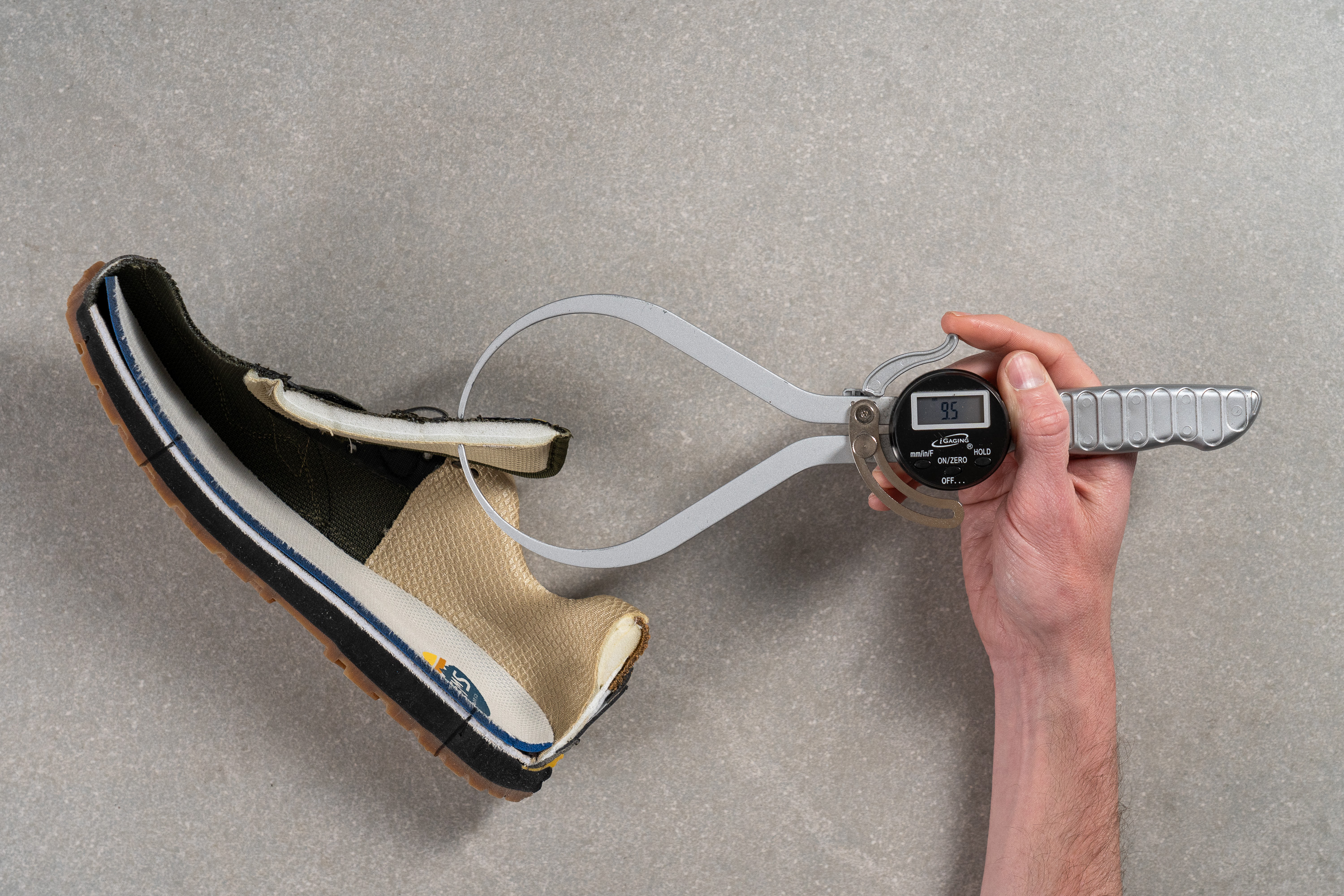
There is also a welcome touch of padding around the collar that adds comfort without bulking up the shoe.
| Trailhead | 9.5 mm |
| Average | 10.2 mm |
Tongue: gusset type
The lack of gussets on the tongue always makes us worried about tongue shifting. Unfortunately, we did experience some tongue sliding while wear-testing the Trailhead.
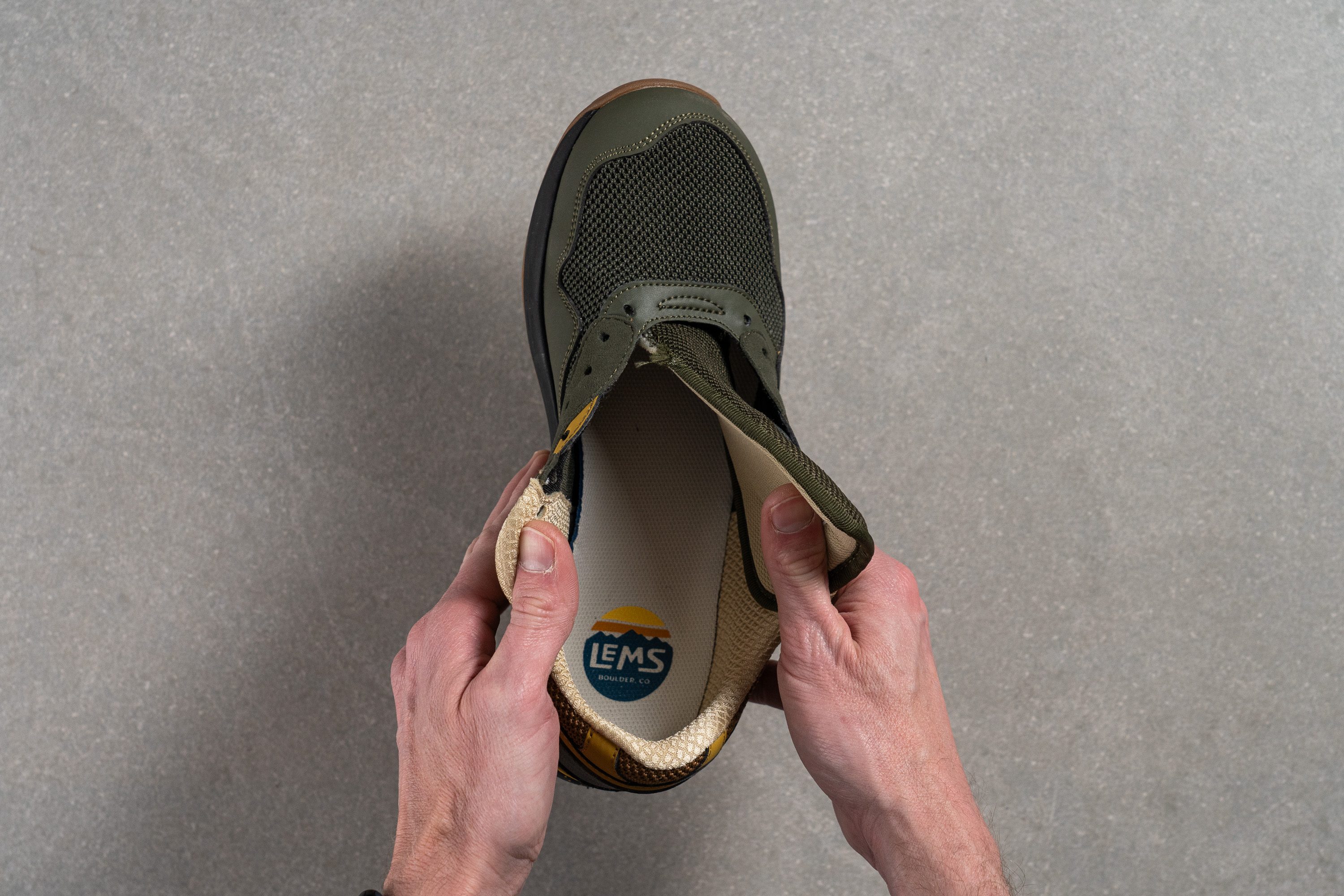
Even though it is a fairly minor issue, it can be very annoying to some people. If that's you, try looking into the Lems Mesa. It has an entirely tongueless bootie upper.
| Trailhead | None |
Heel tab
There are no pull tabs to assist in getting the shoe on but we found the on-and-off to be fairly easy. The shoe mouth is wide enough and the laces don't require much fiddling.
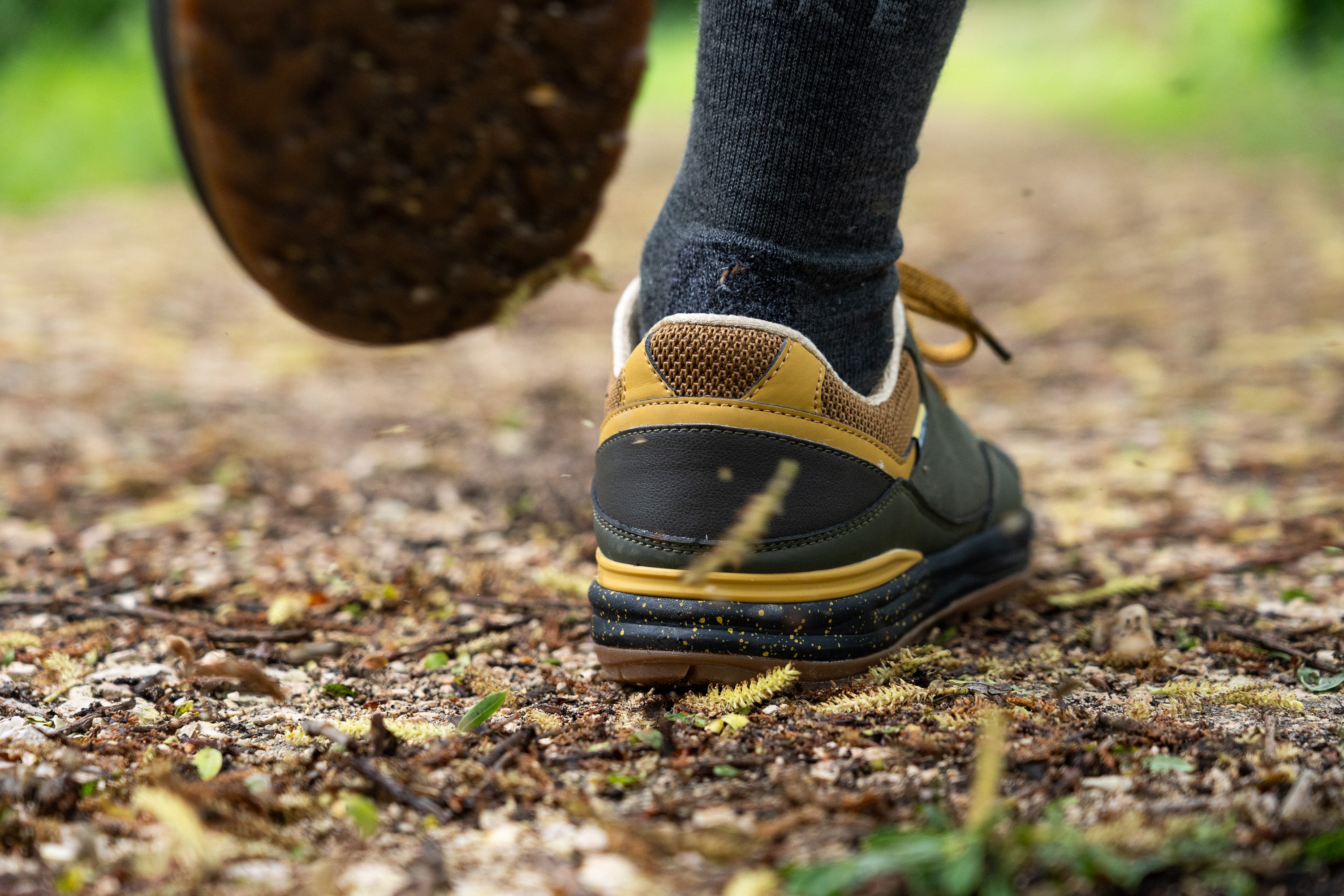
| Trailhead | None |
Vegan materials
Most colorways of the Trailhead use vegan materials in the upper implying that no animal products or byproducts have been used in its production.
Please note that not all colorways of the shoe are vegan:
- Vegan: Cosmic Blue, Sequoia, Stormy Night and Sage (the colorway in this review) use microfiber overlays.
- Non-vegan: Desert Khaki and Mercury Sunset use real suede overlays.


